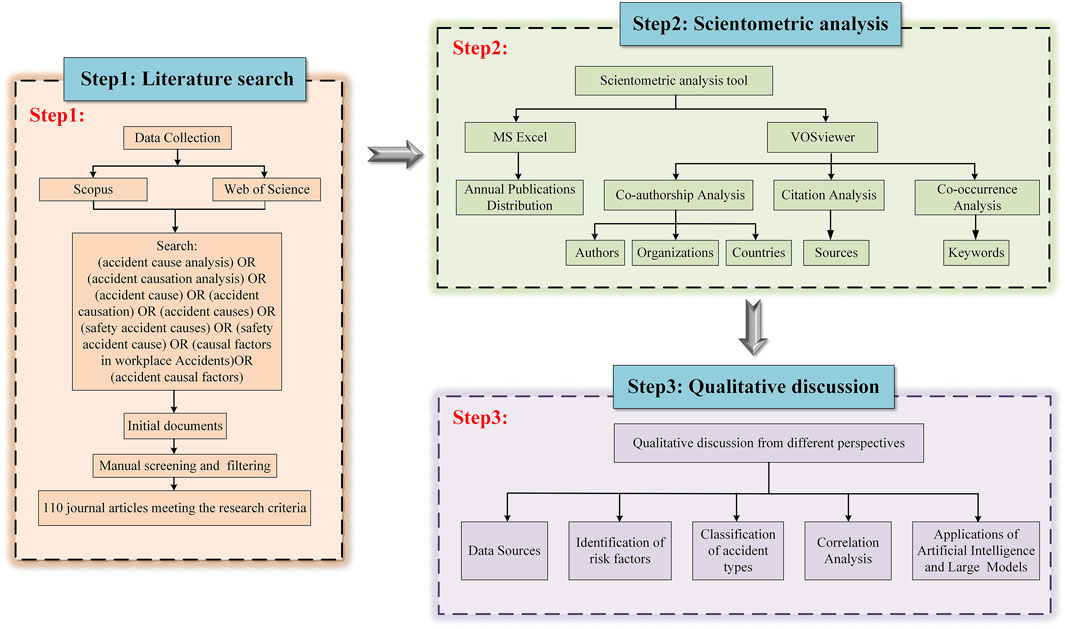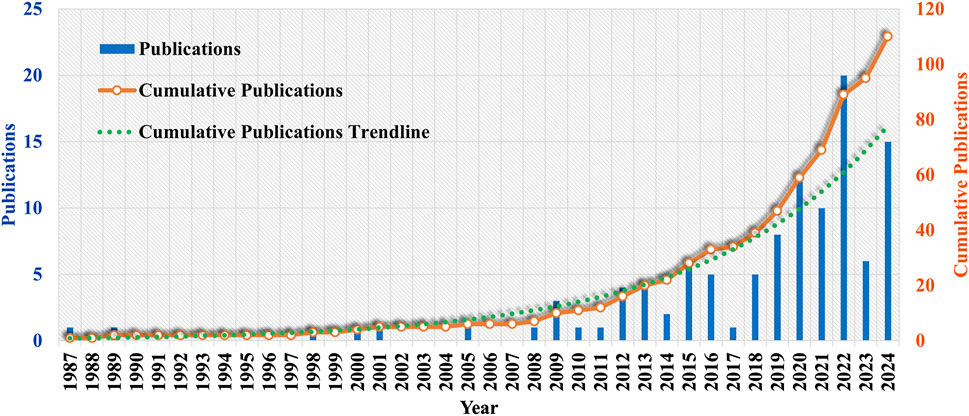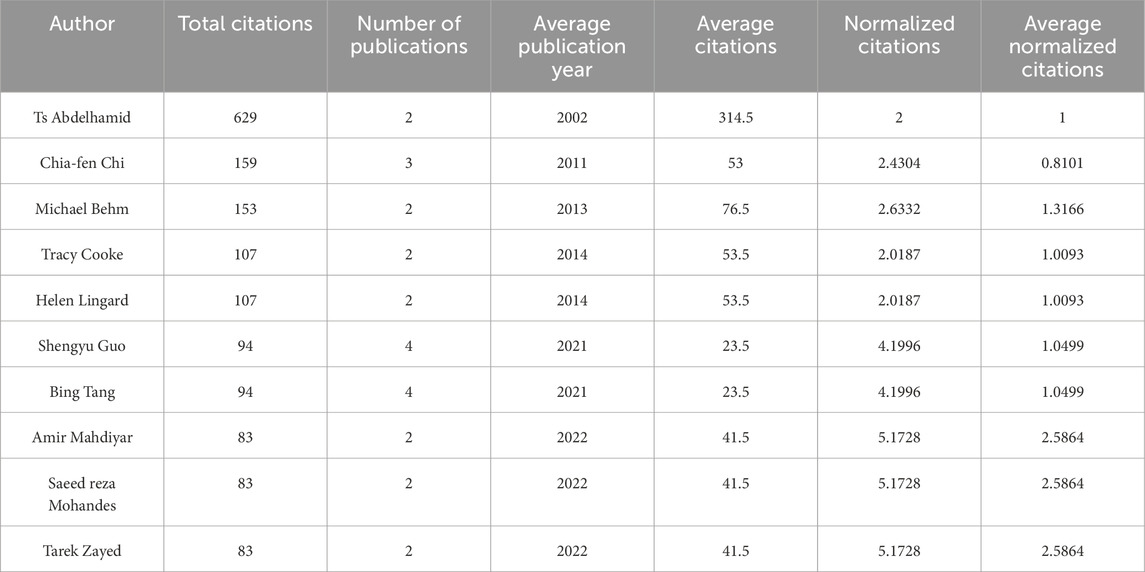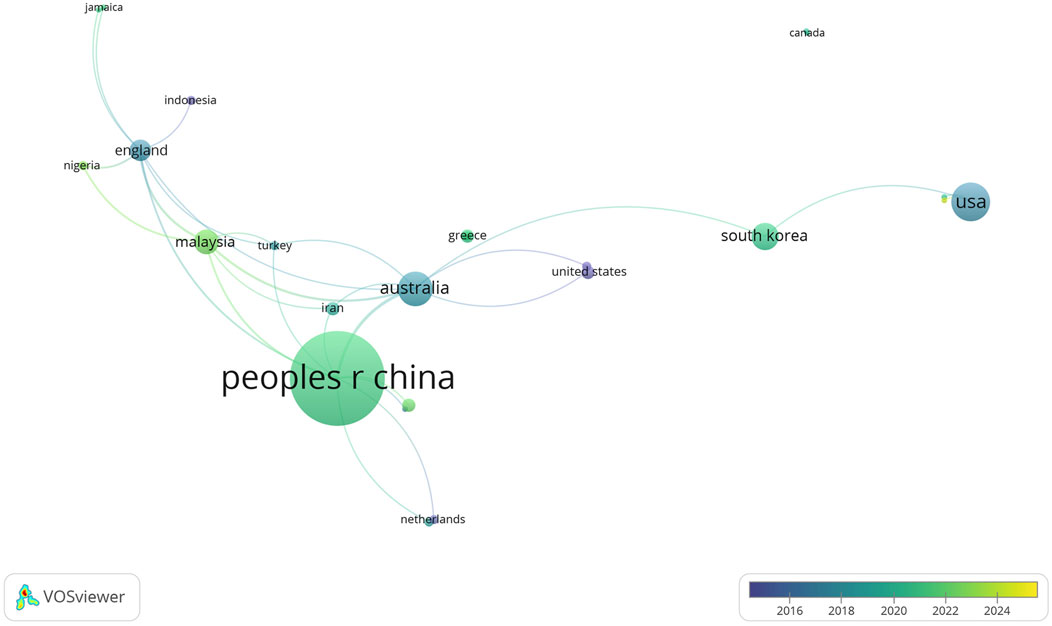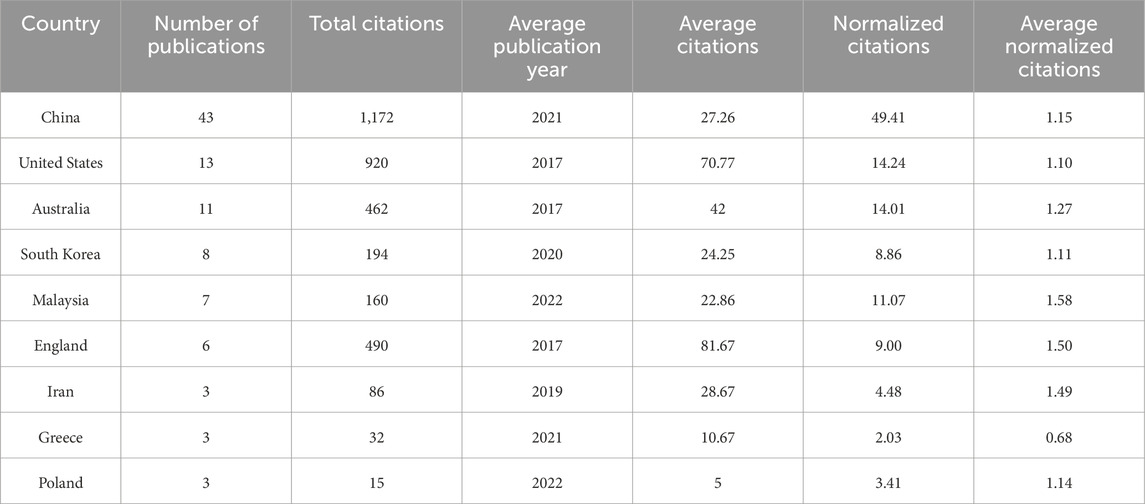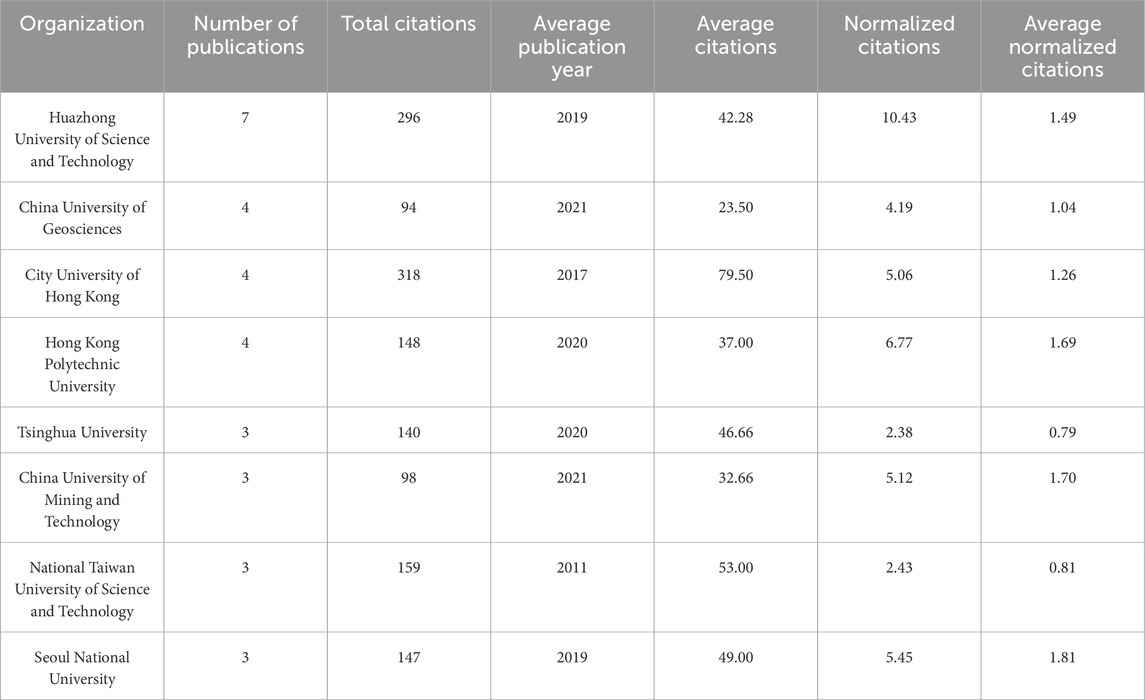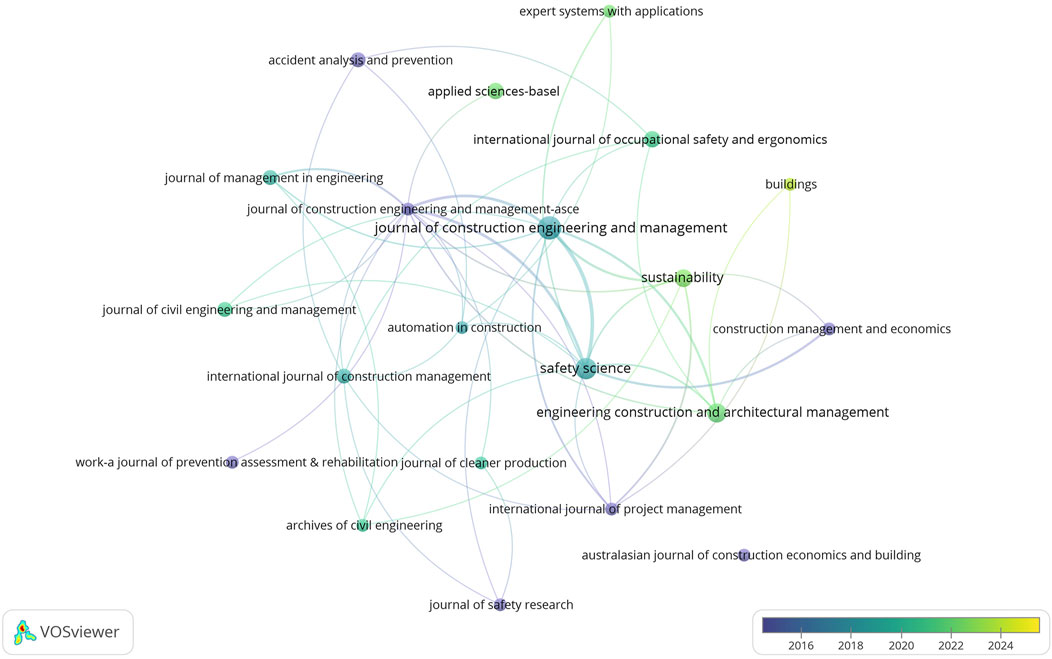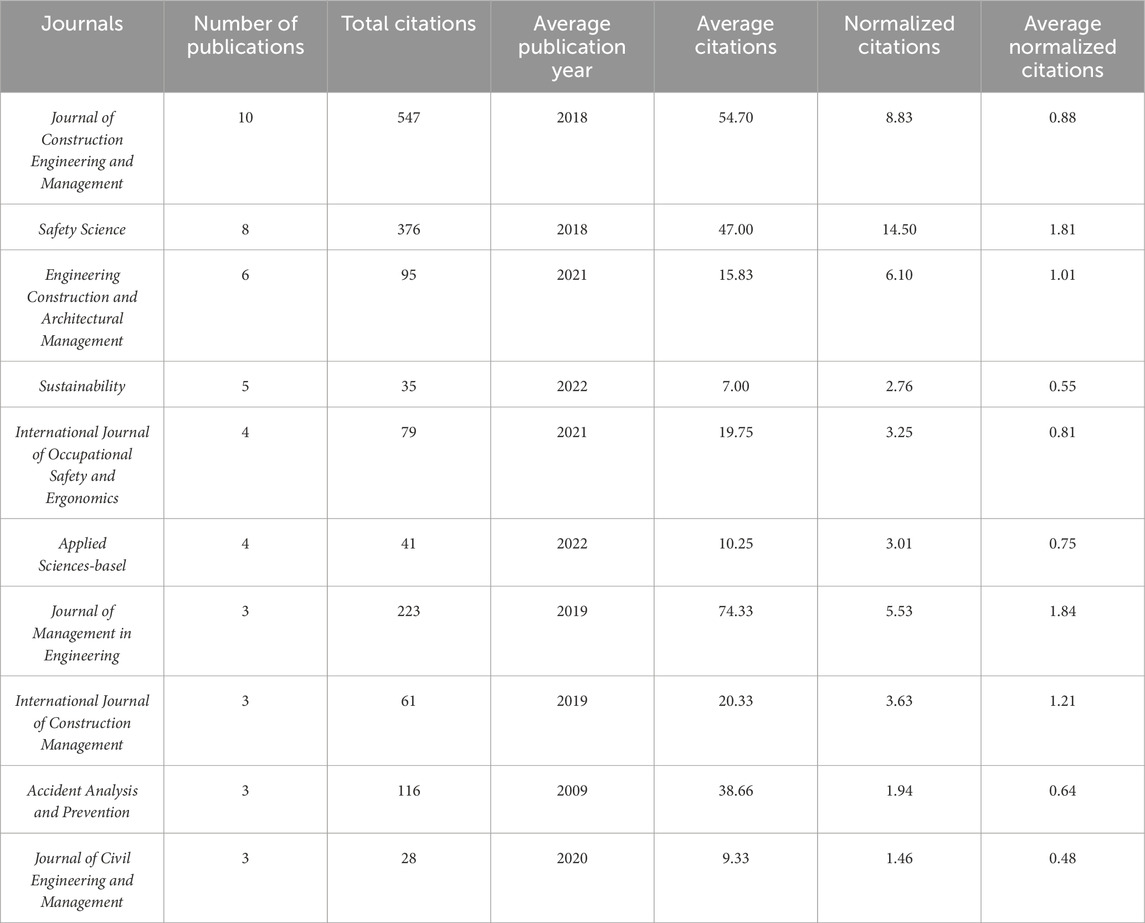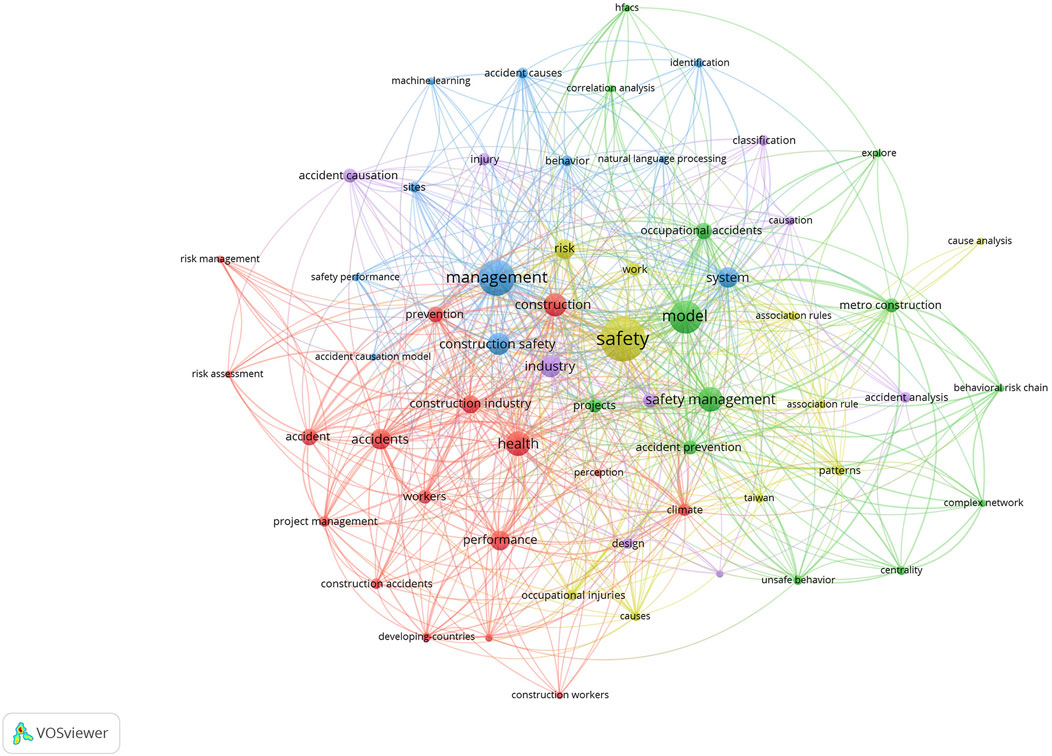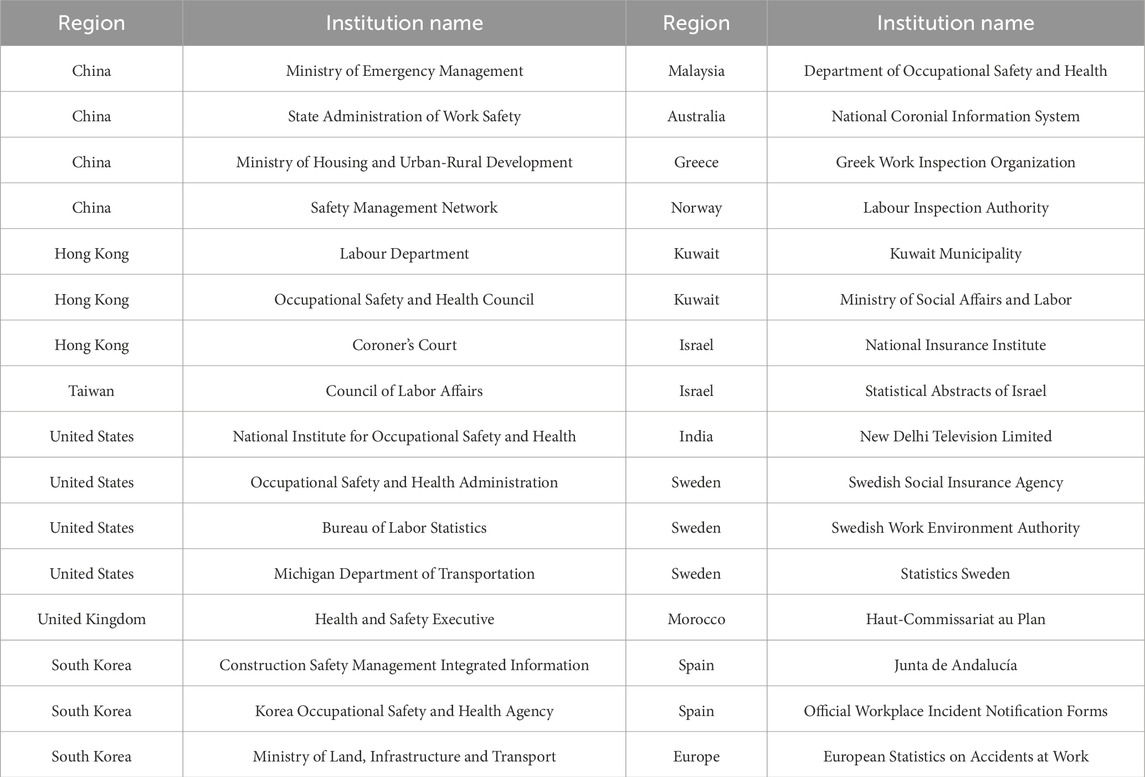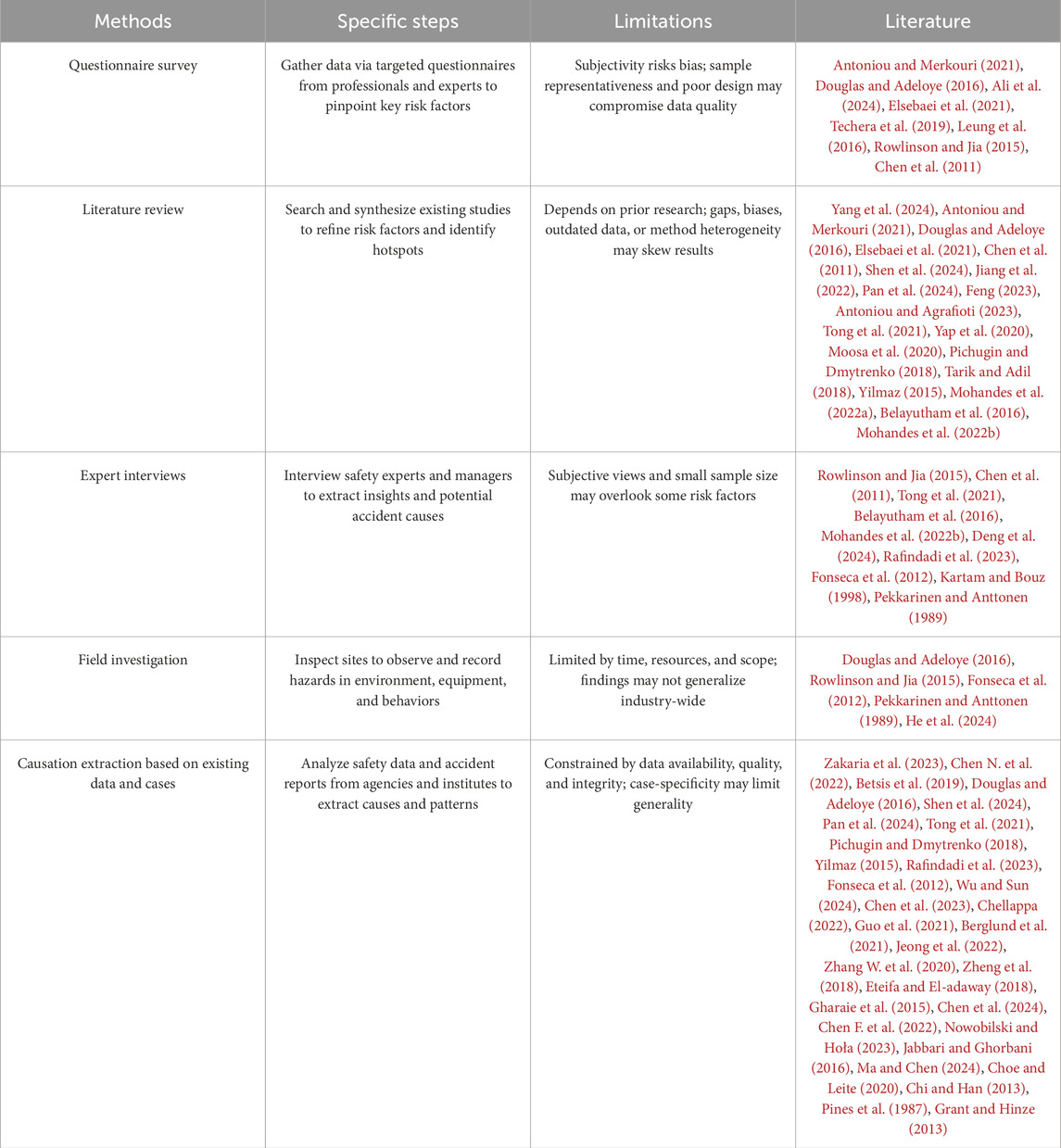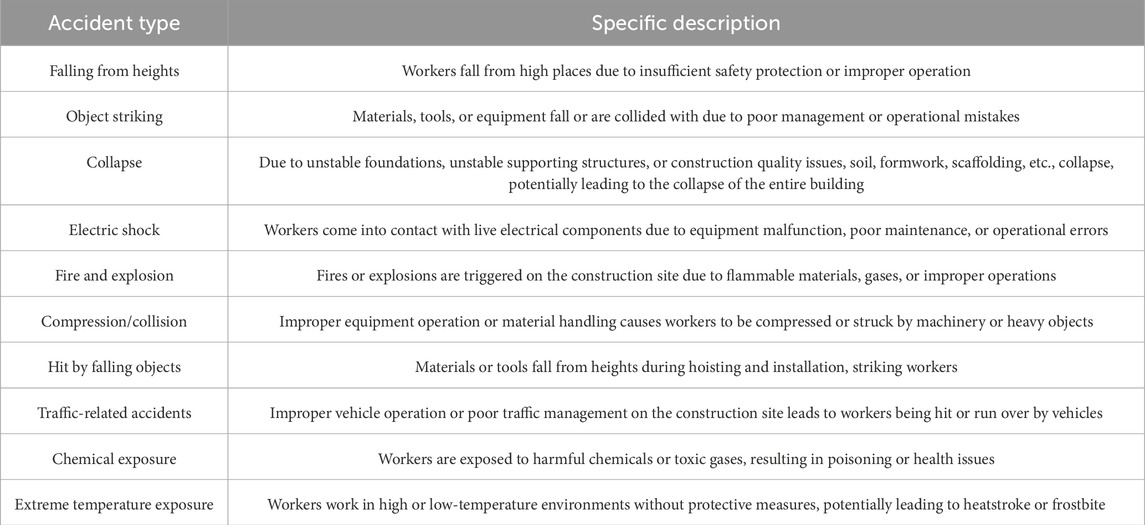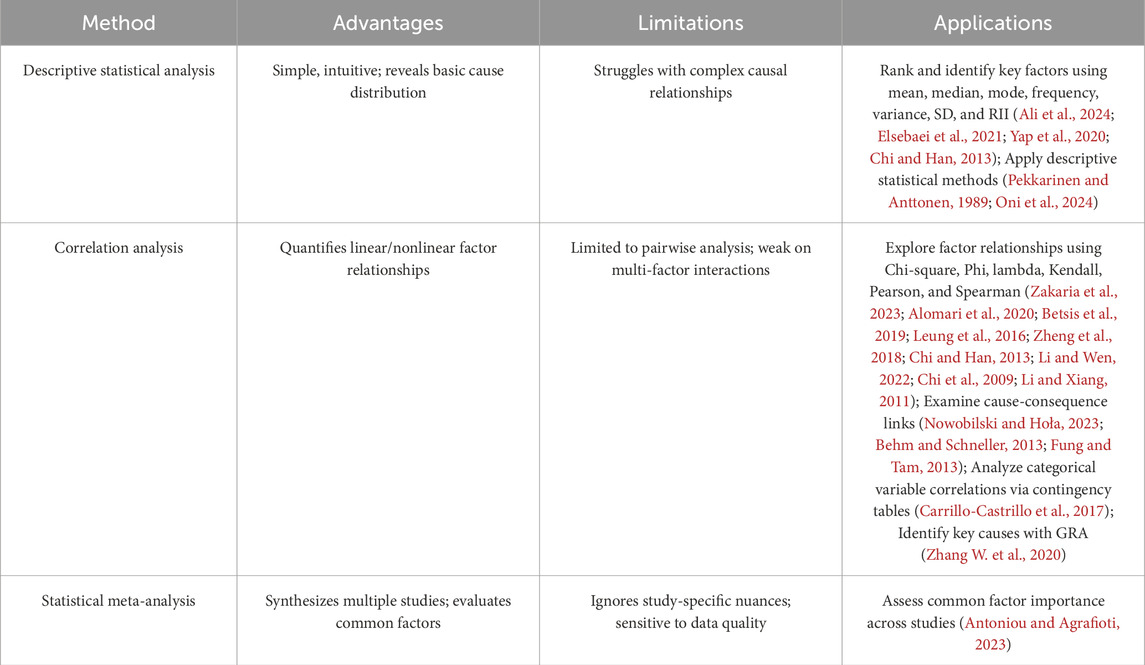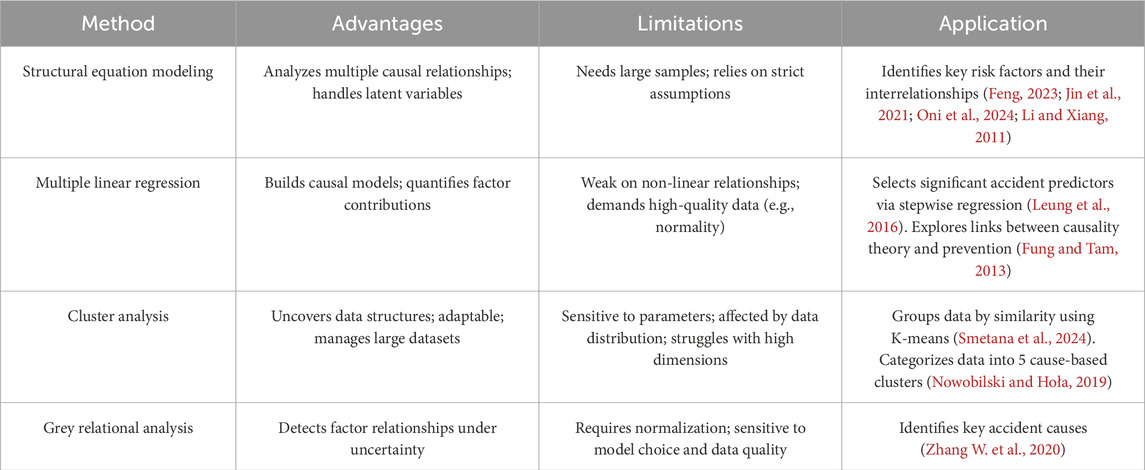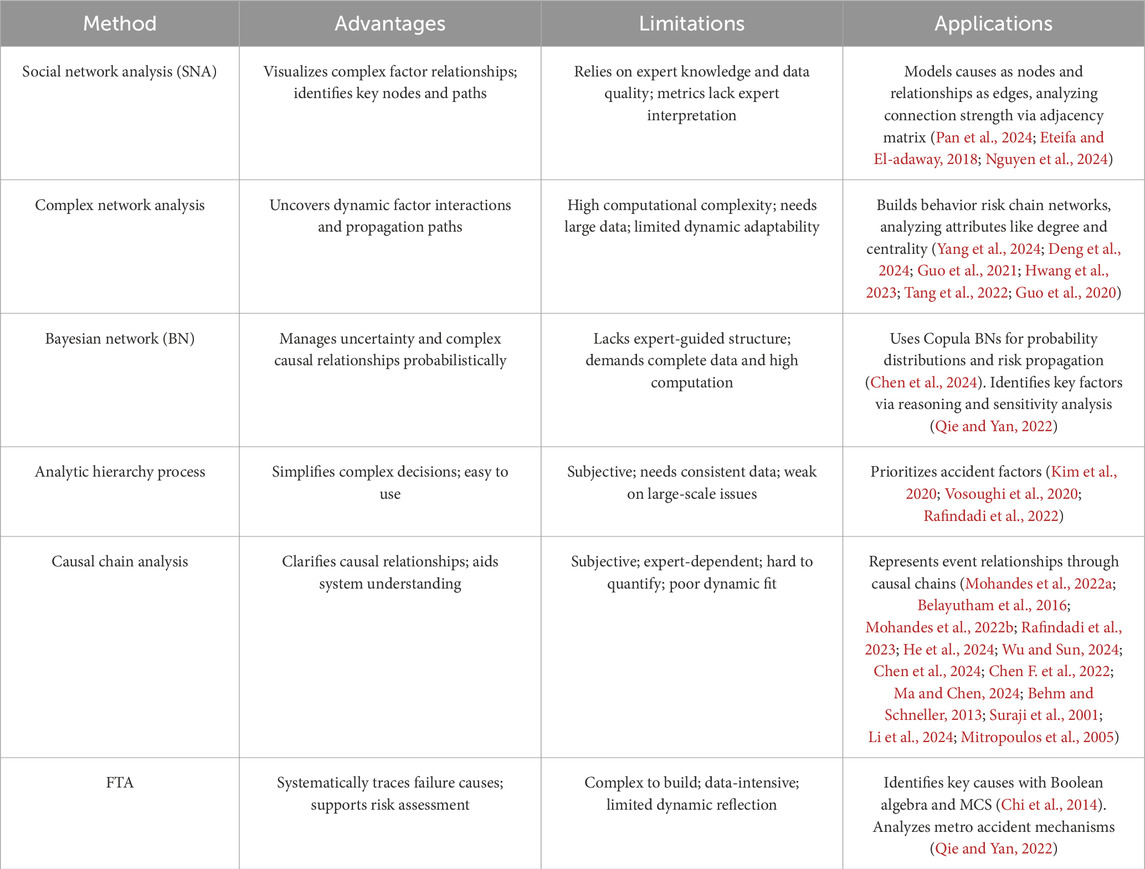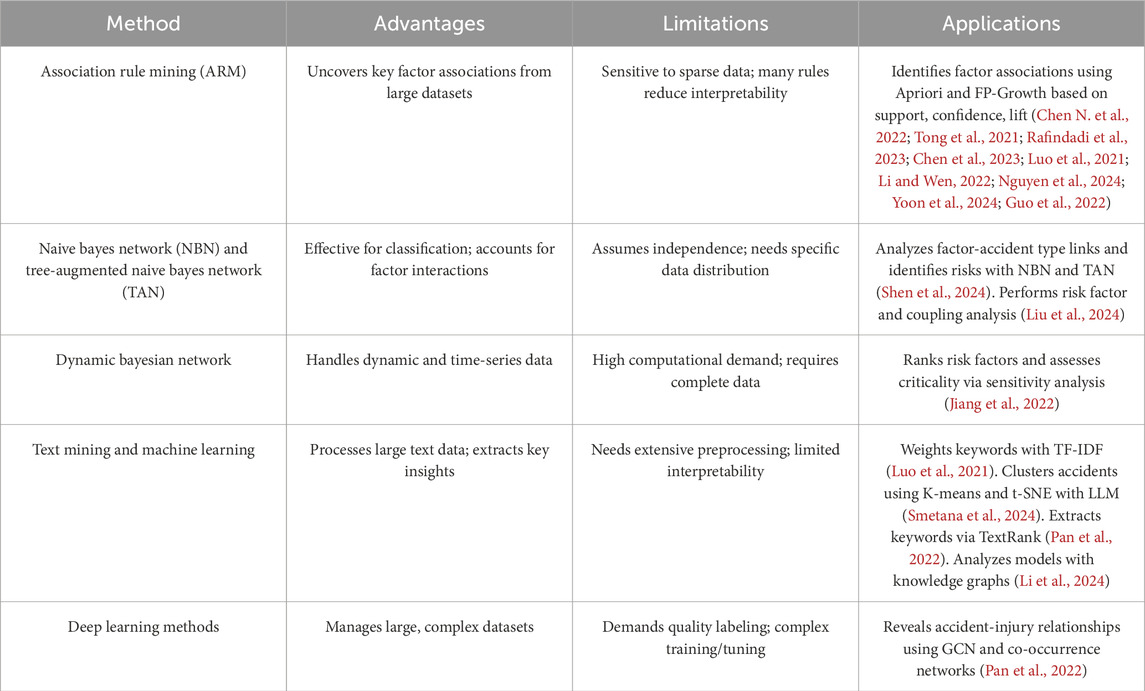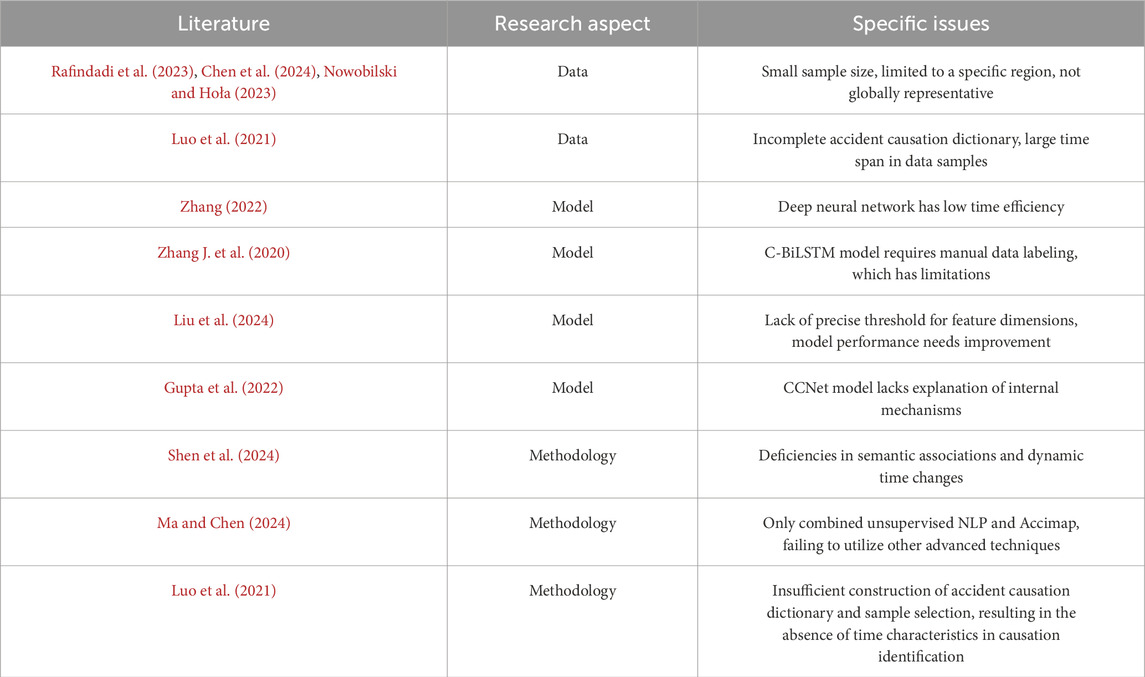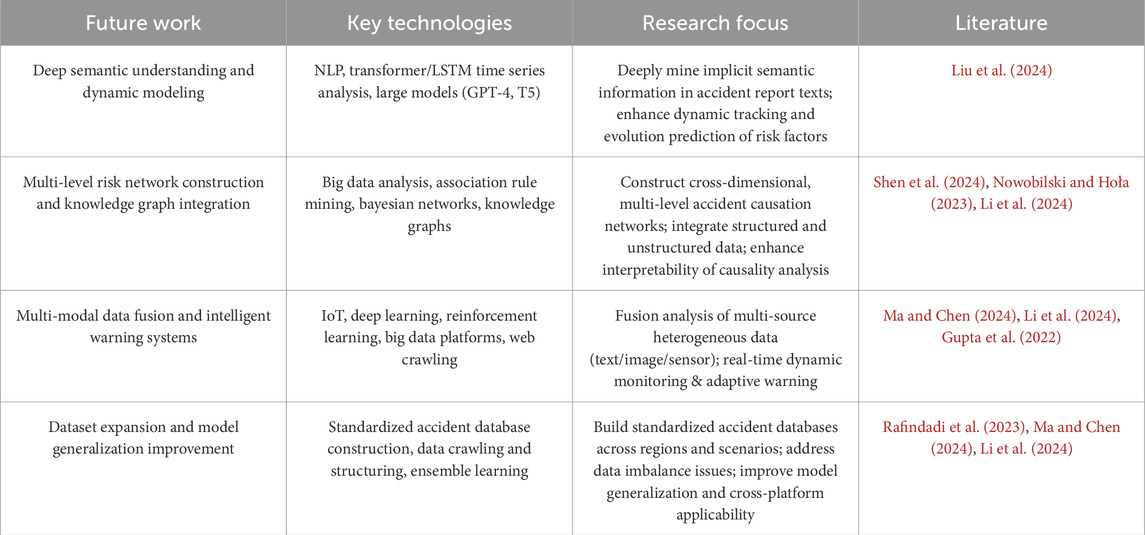- School of Management Engineering, Qingdao University of Technology, Qingdao, China
The construction industry, a cornerstone of global economic growth, faces frequent safety accidents due to its complex environments and multi-party collaboration, impeding sustainable development. These incidents arise from interlinked causal factors, including human error, management shortcomings, technical failures, and environmental conditions. This study systematically reviews construction accident causation research by integrating scientometric analysis and qualitative methods, using VOSviewer to analyze literature from Scopus and Web of Science databases, with 110 peer-reviewed articles selected through a validated Boolean search strategy. VOSviewer was used for bibliometric visualization to map research trends, co-authorship networks, and keyword co-occurrences. In addition, a qualitative synthesis was conducted to review common data sources and examine key issues, including risk factor identification, accident type classification, causality analysis, and the optimization of research strategies. The study aims to systematically review the current state of construction accident causation research, highlighting key trends in data-driven and AI-based safety interventions. Findings reveal a shift toward data-driven, intelligent approaches, with artificial intelligence techniques—such as large models (capable of understanding complex patterns from massive datasets), graph neural networks (suitable for modeling relationships between contributing factors), and natural language processing (for extracting insights from textual accident reports)—enhancing accident prevention and risk prediction. Challenges persist, however, in data quality, causal exploration depth, and interdisciplinary integration. These findings underscore the need for further advancements in data accuracy and model scalability, which could inform more effective safety management practices and policy frameworks. Key contributions include filling the bibliometric gap in this field, offering a novel framework combining quantitative and qualitative insights, and highlighting advanced technology applications, thus providing theoretical and practical guidance for future safety management. Future research is recommended to leverage AI, foster interdisciplinary collaboration, and develop precise prevention systems to address these gaps.
1 Introduction
The construction industry serves as a fundamental driver of global economic growth and urbanization, playing a pivotal role in infrastructure development, urban expansion, and social progress. However, this sector is recognized as inherently high-risk, with a propensity for accidents that can result in severe injuries or fatalities. Establishing an accident-free environment is deemed a central challenge for achieving sustainable development within the industry (Zakaria et al., 2023). Dynamic site conditions, intricate process coordination, competing stakeholder interests, and variable worker competency levels are identified as factors that substantially elevate the likelihood of safety incidents. Globally, statistical evidence indicates that the construction industry sustains one of the highest rates of work-related fatalities, underscoring its persistent accident incidence (Ibrahim et al., 2021; Zhou et al., 2023). Such incidents inflict profound harm on victims and their families while imposing significant economic losses on enterprises, the industry, and society at large. Construction accidents are understood to arise from the interplay of multiple causal factors, where certain elements may trigger others, culminating in an incident (Yang et al., 2024). Identifying risk sources is regarded as a vital step toward accident prevention, with the assessment of these factors’ impacts on safety risks considered equally critical (Alomari et al., 2020). Consequently, addressing and mitigating key causal factors is recognized as an urgent priority in construction accident prevention research.
Investigating the causes of construction accidents carries substantial academic and practical importance. These causes are multifaceted, encompassing human error, technical deficiencies, management shortcomings, and environmental influences. The effective identification and quantification of these factors’ impacts are acknowledged as central academic pursuits (Chen N. et al., 2022). Practically, a thorough analysis of causal factors is seen to underpin construction safety management, facilitating the formulation of evidence-based prevention strategies, reducing accident likelihood, and elevating industry safety standards (Zhang, 2022). In-depth exploration of accident causation is thus viewed as essential for systematic risk factor identification and assessment, while also providing a foundation for refining safety management approaches. A robust safety management system is considered capable of substantially lowering accident rates, minimizing casualties and property damage, and supporting the sustainable advancement of the construction sector. While numerous studies have explored construction accident causation using diverse methodological approaches, there remains a lack of comprehensive reviews that systematically examine the evolution, strengths, and limitations of these methods. Existing literature often adopts singular analytical techniques or focuses on specific cases, making it difficult to form an integrated understanding of methodological developments and to identify emerging trends or opportunities for innovation in this field. This review aims to systematically examine the evolution of research on construction accident causation by integrating scientometric and qualitative approaches, in order to identify key causal factors, analyze their interrelationships, and explore emerging trends and methodological innovations in the field.
In recent years, advancements in data analysis and literature review tools have positioned bibliometric analysis as a valuable method for systematically mapping research hotspots, knowledge networks, and emerging trends in academia. Bibliometric indicators are employed to assess scientific output, explore science-technology interactions, delineate knowledge domains, and trace the evolution of new knowledge, offering insights for strategic planning and competitive positioning (Al Husaeni, 2023). Citation visualization analysis, a key bibliometric technique, has evolved within scientometrics and data visualization to depict interdisciplinary relationships and research patterns through knowledge maps (Chen et al., 2016). Among available tools, VOSviewer is widely adopted across disciplines for its robust visualization and analytical capabilities, enabling the construction of maps via mapping techniques and multidimensional scaling (Rusydiana et al., 2021). This software is utilized to illustrate research topic evolution, institutional and scholarly collaboration networks, and the distribution of prominent research areas, establishing a strong basis for further investigation.
Despite the widespread application of bibliometric methods across various fields (Huang et al., 2022), their use in construction accident causation research remains underexplored. However, no existing study has systematically mapped the knowledge structure of this domain while concurrently evaluating methodological developments and practical trajectories in an integrated manner. Given the interdisciplinary complexity and multidimensional interactions inherent in this domain, bibliometric approaches are seen as well-suited to holistically review its research landscape, uncovering hotspots, gaps, and trends related to key causal factors. Additionally, this methodology is recognized for its ability to highlight influential literature and prominent scholars, fostering academic collaboration and informing research direction decisions. Furthermore, bibliometric analysis is valued for clarifying the thematic structure and developmental trajectory of construction accident causation studies, providing an objective foundation for devising scientifically grounded prevention strategies and advancing both theoretical and practical dimensions of construction safety management. Accordingly, VOSviewer is employed in this study to perform a bibliometric analysis of construction accident causation literature, targeting research hotspots, collaboration networks, and high-impact works to elucidate the field’s knowledge system and trajectory, thereby supporting subsequent research efforts. However, bibliometric methods alone often fall short in capturing the nuanced insights required for interpreting causality and practical relevance in complex fields like construction safety. Therefore, this study strategically combines scientometric analysis with a qualitative review to leverage the strengths of both methods: the former provides a macro-level overview of the research structure and trends, while the latter offers in-depth, contextual understanding of methodologies, causal logic, and technical applications. This mixed-methods approach enhances both the breadth and depth of analysis, allowing for a more comprehensive exploration of construction accident causation.
Construction project accidents represent significant incidents, necessitating detailed analysis to uncover their root causes (Betsis et al., 2019). Existing identification methods are systematically reviewed in this study, with their limitations evaluated and an innovative framework proposed. Accident types are scientifically classified to reveal causality patterns and evolutionary trends, offering a basis for precise prevention and control measures. Correlation analyses of causal factors are examined to identify interactions and refine prevention strategies. The current applications of artificial intelligence and large-scale models are also assessed, with their strengths and limitations analyzed to explore future directions.
The structure of this paper is outlined as follows: Section 2 details the research methodology, encompassing literature retrieval, bibliometric analysis, and qualitative discussion processes; Section 3 presents the bibliometric analysis results, highlighting research trends, knowledge networks, and collaboration patterns; Section 4 provides a qualitative discussion that integrates quantitative findings, systematically addressing data sources, risk factor identification, accident type classification, factor correlations, and the role of artificial intelligence and large models in causation research, while evaluating limitations and future directions; Section 5 concludes with a summary of the findings.
2 Research methods
A scientometric mapping approach is employed in this study to develop a systematic evaluation framework using the widely used three-step approach (Wang et al., 2022a; Wang et al., 2024; Zhang et al., 2024; Fu et al., 2024): literature retrieval, bibliometric analysis, and qualitative discussion. The process is depicted in Figure 1.
During the literature retrieval phase, relevant data were sourced from the Scopus and Web of Science (WoS) databases to establish the research dataset. In the scientometric analysis phase, publication counts across years were statistically analyzed using MS Excel to uncover research trends. Subsequently, VOSviewer (Version 1.6.20) was applied for visualization analysis, generating a knowledge network to pinpoint research hotspots, track evolutionary trends, and evaluate significant contributions and academic influence. Informed by the scientometric findings, a qualitative discussion was conducted to examine key aspects of construction accident causation.
2.1 Literature search
The initial phase of this research involves selecting suitable databases and defining the retrieval strategy. A literature search was conducted using Scopus and WoS, targeting peer-reviewed journal articles in English. Keywords were applied across title, abstract, and keyword fields to ensure comprehensive coverage.
Given the broad scope of construction accident research, an extensive retrieval strategy was implemented. Literature published up to December 2024 was searched using the string: (“accident cause analysis” OR “accident causation analysis” OR “accident cause” OR “accident causation” OR “accident causes” OR “safety accident causes” OR “safety accident cause” OR “causal factors in workplace accidents” OR “accident causal factors”).
The screening process was executed in stages. Initially, titles and abstracts were reviewed to exclude articles unrelated to construction or safety causation. After eliminating duplicates, the remaining articles’ titles, abstracts, and select full texts were thoroughly evaluated to further refine the dataset.
Construction accidents are categorized by location—e.g., residential building sites, tunnels, or roads—reflecting distinctions noted in prior studies (Antoniou and Merkouri, 2021; Douglas and Adeloye, 2016). Infrastructure such as roads, bridges, and buildings is recognized as vital for national development (Zakaria et al., 2023). Thus, this study encompasses accidents across buildings, subways, tunnels, and bridges, aiming for a holistic analysis of causation to enhance safety management perspectives.
Following rigorous screening, 110 relevant journal articles were identified. The selection was based on a structured multi-stage screening process, incorporating relevance assessments, duplicate elimination, and inclusion criteria refinement, to ensure the quality and representativeness of the final dataset. Bibliographic data, including full records and references, were extracted for VOSviewer analysis, enabling the mapping of research hotspots, knowledge networks, and collaboration patterns to support construction accident causation analysis.
2.2 Scientometric analysis
The second phase entails scientometric analysis, a widely adopted method for field evaluation and visualization. Knowledge domains are mapped through this approach (Al Husaeni, 2023). Thematic trends over time were charted using Microsoft Excel to trace the literature’s developmental path. VOSviewer was employed to explore collaboration networks among researchers, countries, and organizations, alongside keyword co-occurrence patterns.
Collaboration networks and thematic associations were generated using VOSviewer, analyzing interactions among research entities and their contributions. Co-authorship networks depict collaboration across researchers, countries, and organizations, while co-occurrence analysis reveals keyword relationships. These visualizations illuminate collaborative dynamics, knowledge diffusion, and key research areas, offering insights into the current state and future directions of construction accident causation research. This approach supports both quantitative and qualitative analyses of the field.
2.3 Qualitative discussion
The third phase involves a qualitative discussion aimed at organizing the literature, analyzing research content, and summarizing progress, challenges, and future trends in construction accident research.
Common data sources in causation analysis were systematically reviewed. Quantitative results from prior phases were integrated with relevant theories to examine risk factors, accident types, causal relationships, and emerging technology applications. Identification methods for accident causation were evaluated for applicability and limitations. Accidents were classified based on their characteristics to clarify typical causes and evolutionary patterns, providing a foundation for precise prevention. Causal relationship analysis methods from existing literature were reviewed, highlighting achievements in identifying causal chains and impact paths to inform prevention strategies. Current applications of artificial intelligence and large models were assessed, with their advantages, limitations, and future directions explored to advance intelligent safety management.
Grounded in systematic literature analysis and scientometric data, this discussion deepens the understanding of construction accident causation. Key issues are clarified, and references for theoretical and practical advancements are provided, supporting the optimization of safety management and accident prevention.
3 Analysis and findings
3.1 Publication outputs
A systematic retrieval and analysis of literature in the field of “construction accident causality analysis” was conducted for this review, aiming not only to illustrate quantitative growth but also to explore the underlying research dynamics and sociotechnical drivers behind the evolution. Publication trends from 1987 to 2024 are presented in Figure 2. The starting year of 1987 was selected as it corresponds to the earliest retrieved literature based on the specified search terms, marking the onset of documented studies in this domain.
In Figure 2, annual publication counts are depicted by a blue bar chart, cumulative totals by an orange line chart, and the cumulative trend by a green dashed line. Between 1987 and 2008, publication numbers remained low and increased slowly, possibly due to limited attention or scarce research resources during that period. A gradual rise in publications was observed from 2009, with a marked surge after 2012, likely driven by global construction industry growth, heightened focus on safety, and advances in research methodologies. A significant uptick in publications after 2019 was noted, potentially linked to increased construction accident frequency, growing societal awareness, and supportive policies. The cumulative publication count mirrors this upward trajectory, accelerating notably post-2019, reinforcing the field’s rising significance. Figure 2 succinctly illustrates the publication growth in “construction accident causality analysis” from 1987 to 2024. The data highlight a steady increase in research interest, with accelerated activity in recent years, signaling the field’s growing prominence in academia and practice. These trends offer insights into research dynamics, potential hotspots, and future directions, providing guidance for researchers and policymakers.
3.2 Co-authorship analysis
Research projects are often complex, necessitating multidisciplinary collaboration to ensure reliable and accurate outcomes (Kahn, 2018). Co-authorship network analysis is recognized as an effective approach for evaluating the novelty and collaboration dynamics of a research field. In this study, it also serves to identify influential scholars, collaborative clusters, and the disciplinary dispersion across institutions and countries. Collaboration scale and intensity are revealed, alongside interaction patterns among researchers. Home countries and affiliated institutions of collaborating authors are identified, shedding light on cross-border and cross-institutional cooperation models. Such analysis provides quantitative evidence of globalization and collaboration in construction accident causality research, supporting future cooperation strategies.
3.2.1 Co-authorship authors
VOSviewer was utilized to analyze the co-authorship network of key authors in construction accident causality analysis, highlighting collaboration relationships and academic influence. Visualization results are presented in Figure 3. A threshold of at least two publications per author was applied, selecting 26 authors from an initial pool of 353 (Rusydiana et al., 2021). Nodes represent authors, with links indicating collaboration, their thickness reflecting intensity, node size denoting publication count, and color signifying average publication year. For instance, “Jianhong Shen,” “Shupeng Liu,” and “Jing Zhang” share an average publication year of 2024, indicating recent contributions aligned with current industry trends. The overall network density is low, suggesting limited integration across research teams. Most scholars contributed only one or two papers and lack sustained cooperation. This pattern reflects the field’s current developmental stage, where cross-institutional and interdisciplinary collaboration is still emerging.
Citation count is widely regarded as an indicator of research quality (Martins et al., 2024). Key quantitative indicators for the top ten authors by citations are summarized in Table 1. “Ts Abdelhamid” (629 citations), “Chia-fen Chi” (159 citations), and “Michael Behm” (153 citations) demonstrate significant impact. In productivity, “Shengyu Guo” and “Bing Tang” each authored four papers, underscoring their notable contributions. Normalized citation metrics, adjusting for publication timing, highlight “Amir Mahdiyar,” “Saeed Reza Mohandes,” and “Tarek Zayed” for their impactful work within their respective periods.
3.2.2 Co-authorship country
International collaboration networks were analyzed using VOSviewer to map the global distribution and influence of construction accident causality research, with a focus on transnational knowledge exchange, policy diffusion, and regional research ecosystems, as shown in Figure 4. A threshold of one publication per country was set, including 33 countries. Nodes represent countries, with link thickness indicating collaboration strength. Quantitative indicators for the top nine countries by publication count are presented in Table 2. China, the United States, Australia, and South Korea lead in output and citations, reflecting robust research capabilities. High citation totals are noted for China, the United States, England, and Australia, with recent contributions from Malaysia, Poland, China, and Greece contrasting with earlier peaks (circa 2017) from the United States, England, and Australia.
3.2.3 Co-authorship institution
Collaboration networks among organizations were examined using VOSviewer, selecting 28 from 158 institutions with a minimum of two publications, as depicted in Figure 5. Nodes signify organizations, their size reflecting publication count, and link thickness indicating collaboration strength. Node color denotes activity level, with yellow indicating higher activity. Huazhong University of Science and Technology and China University of Geosciences exhibit strong inter-organizational ties, while Qingdao University of Technology and Wuhan University are notably active, with South China University of Technology also contributing significantly in recent years. However, international collaboration remains limited. Most institutional ties occur domestically within the same country or region. This indicates that while intra-national partnerships are well-developed—especially in China—transnational institutional collaboration is still in its infancy.
Quantitative indicators for the top eight organizations by publication count are summarized in Table 3, incorporating normalized citation metrics for fair impact comparison across time. Huazhong University of Science and Technology (7 publications, 296 citations), City University of Hong Kong (4 publications, 318 citations), Hong Kong Polytechnic University (4 publications, 148 citations), and China University of Geosciences (4 publications, 94 citations) stand out for productivity and influence.
3.3 Citation sources analysis
Cited journal analysis reveals connections among journals, aiding in the identification of key sources and the evolution of research hotspots. Using VOSviewer, a threshold of two publications per cited journal was set, selecting 21 out of 57 journals for analysis. A collaboration network diagram was generated, as shown in Figure 6. Nodes represent journals, with size indicating publication count and link thickness reflecting collaboration strength. The clustering patterns indicate interdisciplinary integration, especially between engineering management, safety science, and artificial intelligence.
In terms of collaboration, Journal of Construction Engineering and Management and Safety Science exhibit the strongest ties with other organizations’ researchers. Node color denotes activity level, with yellow indicating higher activity. Buildings is identified as the most active, followed by Expert Systems with Applications, Sustainability, and Applied Sciences-Basel, reflecting their recent, trend-aligned contributions.
Quantitative indicators for influential journals are summarized in Table 4, ranked by publication count. Journal of Construction Engineering and Management (10 publications), Safety Science (8 publications), and Engineering Construction and Architectural Management (6 publications) emerge as leading contributors. Normalized citation metrics, adjusting for publication timing, highlight Safety Science and Journal of Construction Engineering and Management as having the most impactful papers within their periods.
3.4 Co-occurrence keyword
Keywords summarize research focus, and their analysis identifies hotspots and emerging topics (Yang et al., 2021). A co-occurrence network was constructed using VOSviewer, as shown in Figure 7, with a threshold of three appearances per keyword. Nodes represent keywords, with size proportional to frequency, link thickness indicating co-occurrence strength, and color reflecting clustering.
Five clusters are delineated in Figure 7, each highlighting distinct yet interconnected aspects of construction safety research. Cluster 1 (Red), the largest with 17 keywords, addresses “occupational safety,” “risk assessment,” “prevention,” and “project management.” This cluster emphasizes worker safety and performance in developing countries, with a focus on macroscale management and project-level safety controls. Cluster 2 (Green), with 13 keywords, explores “accident prevention,” “behavioral risk chains,” “complex networks,” and “safety management models.” This cluster integrates risk strategies and lifecycle accident perception analysis, emphasizing a systematic safety management model that merges behavioral science with risk control. Cluster 3 (Blue), containing 11 keywords, focuses on “accident cause identification,” “behavioral analysis,” “machine learning,” and “natural language processing.” This cluster emphasizes data-driven approaches, using machine learning and natural language processing technologies to enhance site safety in a systematic manner. Cluster 4 (Yellow), with 10 keywords, examines “occupational injury causes,” “association rules,” and “safety patterns.” This cluster focuses on in-depth causal analysis, particularly in regions like Taiwan, highlighting safety patterns and behavioral rules specific to these areas. Cluster 5 (Purple), the smallest with nine keywords, targets “accident analysis,” “causal factors,” “classification,” and “design frameworks.” This cluster focuses on design frameworks for safety improvements, exploring accident analysis and causal factor classification to drive more effective safety designs and management. These clusters, while distinct, exhibit interconnections that reflect the complexity and overlap in the field, offering a multidimensional perspective on research dynamics and trends to guide future hotspot identification.
4 Qualitative discussion
The scientometric analysis conducted in the previous section offers a data-driven overview of the intellectual landscape in construction accident causation research. To further interpret and contextualize these findings, the following qualitative analysis delves into key thematic areas that have emerged as focal points across the literature. While informed by the clustering patterns and keyword co-occurrence trends, this part moves beyond citation metrics to explore the conceptual, methodological, and practical dimensions of the field. In doing so, it bridges the quantitative patterns with in-depth content analysis, offering a more nuanced understanding of research priorities, challenges, and developments.
Data sources are systematically organized in this section from a qualitative perspective, integrated with quantitative analysis results. Risk factor identification, accident type classification, and interrelationships among factors in construction accident causation studies are explored. Concurrently, the current applications and limitations of artificial intelligence and large models in this field are assessed, with future research directions outlined.
4.1 Data sources
The diversity and quality of data sources in construction accident causality analysis directly influence the scientific validity and reliability of findings. A thorough review of 110 relevant articles revealed reliance on varied sources, including questionnaires, expert interviews, literature reviews, field surveys, and accident investigation reports. Each source contributes significantly to uncovering accident causes, analyzing risk factors, and proposing enhancements. Accident investigation reports, compiled post-incident by authoritative agencies or professional teams, are distinguished as a primary source due to their detailed, comprehensive, and credible content, providing a robust basis for causal analysis and risk identification (Zhang J. et al., 2020). Acquisition methods for these reports and associated institutions across countries and regions are detailed in Table 5. However, it is worth noting that the reliability, consistency, and completeness of these data sources may vary across regions and institutions. Therefore, researchers should critically assess potential biases or gaps inherent in specific datasets when conducting causality analysis.
4.2 Identification and extraction of construction accident causality factors
Risk factor identification is recognized as the foundational step in safety risk management, essential for assessing risk levels and formulating mitigation strategies (Gul and Ak, 2018). Common accident causes in construction are pinpointed to guide safety practitioners in prioritizing preventive measures across project stages (Carrillo-Castrillo et al., 2017). Causality factors are analyzed scientifically to manage project risks effectively, ensure safety, enhance worker wellbeing, and support sustainable industry development, while also improving enterprise competitiveness and resilience against future risks.
4.2.1 Traditional methods
Various research methods for data collection, accident pattern analysis, and causality extraction are employed, each with distinct advantages and limitations. Multiple approaches are often combined to enhance result reliability and comprehensiveness. Traditional methods—surveys, literature reviews, expert interviews, site inspections, and causality extraction from existing data and case studies—are systematically reviewed, with specific steps, limitations, and supporting literature outlined in Table 6 to serve as a reference for future research. As shown in the table, traditional methods for identifying construction accident causation factors exhibit a trade-off between depth of insight and data generalizability. While expert-based and site-specific approaches (e.g., interviews, field investigations) offer detailed and contextualized knowledge, they often suffer from subjectivity and limited coverage. Conversely, methods relying on existing literature or institutional data allow for broader pattern recognition but may be constrained by data quality or research bias.
4.2.2 Advanced analysis and modeling methods
Advancements in technology and data processing have led to the adoption of sophisticated methods in construction accident causal analysis. Digital tools enable risk factor extraction from unstructured reports (Liu et al., 2024). Techniques such as natural language processing (NLP), deep learning, and statistical modeling, alongside complex system analysis, are utilized to deepen causal insights. NLP and machine learning models (e.g., KeyBERT, BERT) paired with clustering techniques extract key factors from extensive accident reports (Liu et al., 2024), while text mining reveals accident patterns in large datasets (Shen et al., 2024; Luo et al., 2021). Novel NLP, dimensionality reduction, clustering, and large language model (LLM) prompts are integrated to identify accident types and causes (Smetana et al., 2024). Probabilistic models like HFACS, refined with qualitative comparative analysis, and the modified loss causal model establish causal chains and relationships (Li and Wen, 2022; Wang et al., 2022b; Chan et al., 2022). Deep learning approaches, such as the HANN model (Zhang, 2022), handle nonlinear modeling of complex datasets, while system models like ConAC and the Constraint-Response Model uncover intrinsic accident mechanisms (Winge et al., 2019; Behm and Schneller, 2013; Suraji et al., 2001). Fault tree analysis (FTA) combined with Boolean algebra and case studies further refines causal factor identification (Chi et al., 2014). These advanced methods surpass traditional approaches in depth and applicability, with ongoing technological progress promising enhanced accuracy and a stronger foundation for safety management.
4.2.3 Comprehensive analysis
Traditional methods, such as surveys, literature reviews, and expert interviews, are valuable for identifying accident causality factors but often face limitations in terms of accuracy and generalizability due to small sample sizes and subjectivity. These methods are typically more interpretable, providing direct insights, but they may overlook underlying patterns that advanced techniques can uncover. In contrast, advanced methods such as natural language processing (NLP) and deep learning offer enhanced accuracy by analyzing large datasets and identifying complex causal relationships. However, these methods often lack transparency, making it difficult for practitioners to fully understand the rationale behind the results. While traditional methods remain crucial for site-specific analysis and expert judgment, advanced methods are increasingly relevant as they enable more comprehensive, data-driven insights. The integration of both approaches can provide a more robust and effective framework for construction accident prevention.
4.3 Classification of construction accident types
Diverse and frequent construction safety accidents arise from complex risk factors (Shen et al., 2024). Accident type analysis is deemed critical for improving safety management (Smetana et al., 2024). Various classification methods proposed by scholars and institutions globally are reviewed to elucidate accident mechanisms and inform targeted safety recommendations (Zheng et al., 2018). Accidents are classified to aid prevention, emergency response, and the development of industry standards and safety technologies. Classification methods and accident type distributions across construction sectors and countries are examined, providing theoretical support for strengthening safety management practices.
4.3.1 Analysis of construction accident types
Classification methods for construction accidents are predominantly based on multiple dimensions, such as direct causes, physical manifestations, and regional factors. Accidents are attributed to human unsafe behaviors, unsafe object conditions, environmental factors, and management deficiencies (Shen et al., 2024), or categorized by manifestations like falls from heights, object strikes, and collapses (Yang et al., 2024). With construction companies increasingly operating internationally, heightened safety risks and uncertainties are encountered (Jin et al., 2021). Risks in global projects stem from countries, partners, companies, and project-specific factors (Zhu et al., 2022), with Heinrich’s theory applied to classify accidents into traditional and non-traditional safety risks, environment- and health-related incidents, and socio-cultural conflicts, aiding cross-cultural safety management (Jin et al., 2021). Regional studies highlight distinct risk profiles, offering valuable insights for multinational projects. Innovative classifications, such as work area intersections (high-altitude, ground, or combined cross-working) (Chen et al., 2023) and severity levels (general, major, serious, particularly serious) (Chen N. et al., 2022), refine risk characterization, noting that falls, collapses, strikes, and lifting injuries dominate (∼80% of incidents). Additional categories—entrapment, electrocution, chemical exposure, temperature extremes, fires, explosions, and traffic accidents—are also recognized (Zhang J. et al., 2020). Advanced tools like graph neural networks are employed to classify unstructured reports efficiently (Pan et al., 2022), while the Task-Competence-Interaction model links accident risk to mismatches between task demands and worker capabilities (Kartam and Bouz, 1998). These multidimensional approaches, evolving toward standardization and dynamism, provide robust theoretical support for safety management, with future efforts urged to align classification with practical safety enhancements.
4.3.2 Summary of construction accident types
Accident type frequency and proportion in construction vary by research perspective and data source. Falls from heights, object strikes, and collapses consistently predominate, with falls leading across studies (Zakaria et al., 2023; Betsis et al., 2019; Jabbari and Ghorbani, 2016), while electrocution, fires, and explosions, though less frequent, remain significant risks (Rafindadi et al., 2023; Hwang et al., 2023). These patterns inform targeted safety measures. Common accident types are refined based on physical manifestations and prior research, as detailed in Table 7. Scientific classification underpins safety management by linking accident types to specific work environments, operational methods, and management factors, enabling precise prevention strategies. Major categories—falls, strikes, collapses, electrical shocks, and fires/explosions—alongside specific incidents like falling object strikes, traffic accidents, chemical exposure, and temperature extremes, are delineated to enhance risk assessment and training. Future refinements, integrating dynamic analysis and modern technology with occurrence data, are expected to bolster safety management guidance.
4.4 Causal factor correlation analysis methods and applications
Causal factors are recognized to potentially trigger one another, ultimately leading to accidents (Yang et al., 2024). Understanding these mechanisms is deemed essential for accident prevention, enhancing construction management and technical capabilities (Qie and Yan, 2022). Causal factors and their interrelationships are analyzed from four perspectives—traditional statistical, advanced statistical, network- and structure-based, and advanced data analysis methods—to identify key factors and construct accident chains, thereby supporting risk control, industry safety, and sustainable development.
4.4.1 Traditional statistical analysis methods
Traditional statistical methods are employed as foundational tools for identifying accident causes and exploring simple relationships in construction accident analysis. Their limitations in addressing complex causal interactions are acknowledged, as detailed in Table 8. Combining these with advanced techniques is recommended to achieve more comprehensive insights. This table highlights the complementary nature of traditional statistical methods in causation analysis. Descriptive statistics provide an accessible overview of factor distributions, while correlation analysis enables deeper exploration of pairwise relationships. Meta-analysis serves to integrate findings across studies but may obscure contextual variability. Together, these methods offer a layered understanding of causation patterns, though each carries limitations in handling complex or multifactorial interactions.
4.4.2 Advanced statistical analysis methods
Advanced statistical methods are increasingly applied to uncover risk factors and their interrelationships in construction accident causation, enabling the development of robust analysis models for improved prevention and management accuracy. Challenges related to applicability, data needs, and computational complexity are outlined in Table 9. The table reflects a growing tendency toward the use of more sophisticated analytical techniques in causation studies. These approaches offer expanded capabilities for exploring hidden patterns, complex relationships, and uncertainty within the data. While they hold promise for producing more nuanced insights, their effective application often hinges on appropriate methodological design and data conditions.
4.4.3 Network and structure-based analysis methods
Network- and structure-based methods are utilized to reveal complex factor interactions, pinpoint key elements, and trace influence pathways in construction accident analysis. Their strengths in managing complex systems and dynamic interactions are highlighted, though high demands on network construction, data quality, and computation are noted in Table 10.
4.4.4 Advanced data analysis methods
With digital technology advancements, advanced data analysis methods are leveraged to process large-scale data and uncover intricate relationships in construction accident causation through sophisticated algorithms. These methods support accident prevention by identifying underlying patterns, yet face challenges such as limited interpretability, high costs, and reliance on specialized expertise, as presented in Table 11. The table illustrates a gradual shift toward structural and network-based thinking in causation analysis. These methods help to represent complex interdependencies and visualize cause-effect linkages in more systematic ways. Although promising in theory and structure, their effective use still relies on suitable data inputs and careful model interpretation.
4.4.5 Comprehensive analysis
Traditional statistical methods offer strong interpretability and ease of use but struggle to capture the multifactorial and nonlinear relationships often present in construction accidents. In contrast, advanced statistical and network-based approaches demonstrate superior accuracy and structural insight, yet they typically require large datasets and involve complex modeling processes, limiting their practical applicability. Advanced data-driven techniques—such as machine learning and deep learning—excel at handling large-scale data and detecting hidden patterns, but often suffer from limited transparency and high computational and expertise demands. Therefore, a trade-off exists between interpretability and analytical capability across different methods. To address this gap, an integrated analytical framework combining traditional, advanced statistical, and data-driven methods can be adopted. This approach enhances the robustness and comprehensiveness of causal factor analysis by leveraging the strengths of each method, ensuring more accurate and holistic insights into construction accident causation. Collaborative approaches, such as combining statistical and machine learning techniques (Rafindadi et al., 2023; Li and Wen, 2022; Nguyen et al., 2024) or Bayesian networks with SNA, are adopted to enhance accuracy and model propagation paths, despite challenges like computational demands and integration barriers. Methods or combinations are selected based on research goals, data traits, and resources to yield precise, comprehensive causation insights.
4.5 The application of artificial intelligence and large models and future prospects
4.5.1 Application progress of artificial intelligence and large models
Emerging technologies, including big data, artificial intelligence (AI), and the Internet of Things (IoT), are harnessed to support real-time monitoring, accident prevention, and causal analysis in construction, significantly enhancing safety management (Deng et al., 2024). AI and large models are increasingly applied to identify risk factors, analyze causal relationships, and predict risks, offering intelligent, data-driven solutions. Text mining combined with Bayesian networks extracts risk factors from reports using algorithms like TF-IDF and TextRank, with improved Bayesian models identifying key factors despite limitations in semantic and temporal dynamics (Shen et al., 2024). Dynamic Bayesian networks and N-K models are utilized to assess risk coupling in deep excavation near tunnels, aiding on-site safety decisions (Jiang et al., 2022). Metro accident causality networks, built via data mining and network theory, reveal topological links between accidents and factors, optimizing safety resource allocation (Deng et al., 2024). The BERT and TAN model achieves high performance (AUC 0.938) in risk factor extraction (Liu et al., 2024), while GPT-3.5, paired with NLP and clustering, analyzes OSHA data for real-time safety advancements (Smetana et al., 2024). ARM uncovers risk factor combinations—e.g., management, site conditions, and behavior in Malaysia (Rafindadi et al., 2023)—and patterns in cross-operations (Chen et al., 2023) and fall accidents (Luo et al., 2021). Text classification and causal modeling are advanced through Word2Vec and hybrid neural networks (Zhang, 2022), convolutional bidirectional LSTM (C-BiLSTM) for OSHA narratives (Antoniou and Merkouri, 2021), Copula Bayesian networks for collapse accidents (Chen et al., 2024), and NLP with Accimap for systematic risk analysis (Ma and Chen, 2024). Fault tree analysis with Bayesian networks dynamically assesses subway accident risks (Qie and Yan, 2022), and contextual semantic networks (CCNet) enhance classification using deep learning and attention mechanisms (Gupta et al., 2022). Tunnel accident databases highlight geological unpredictability (Sousa and Einstein, 2021), while knowledge graphs integrated with BIM identify high-risk factors like unsafe behavior and poor management (Li et al., 2024). Python-based processing of complex data aligns with deep learning for future intelligent systems (Nowobilski and Hoła, 2023). These technologies collectively bolster analysis efficiency, accuracy, and decision-making in construction accident causation.
4.5.2 The limitations of artificial intelligence and large models and future prospects
While the AI models mentioned show potential in risk factor identification and accident causation analysis, their effectiveness, scalability, and feasibility in real-world applications require further evaluation. Practical implementation depends on data quality, model adaptability, and integration with existing safety management systems. Validation in real-world projects is essential to ensure accuracy and reliability. Scalability remains a concern, especially in resource-limited smaller projects. A comprehensive evaluation of model performance is crucial for optimizing their broader application.
Limitations in data, models, and methods are encountered in current research, as detailed in Table 12. Advances in AI, large models, and data mining offer new opportunities for construction accident causation analysis. Future research directions, outlined in Table 13, emphasize improving risk identification accuracy and intelligence. The integration of these technologies is poised to deliver precise, efficient solutions, though ongoing efforts in data quality, model optimization, and interpretability are required to ensure practical, scalable outcomes for construction safety management. Particularly, the challenges related to data quality, such as incomplete or biased datasets, can significantly impact model performance and generalization across diverse construction contexts.
In addition to technological advancements, it is crucial to consider the ethical and policy implications of AI-based accident prediction models. Issues such as data privacy, algorithmic fairness, and transparency in decision-making should be carefully addressed to ensure that these models are used responsibly and effectively in construction safety management. Furthermore, policy frameworks may need to be updated to support the integration of AI in safety protocols, ensuring that the models are aligned with industry standards and regulatory requirements.
5 Conclusion
This review offers a comprehensive understanding of the evolving landscape of construction accident causation research, highlighting a transition from traditional qualitative approaches to data-driven, intelligent methodologies. Beyond identifying key hotspots and influential networks, the findings underscore a broader epistemological shift: the integration of advanced computational techniques—such as AI, large models, and graph-based learning—is reshaping how causality is conceptualized, modeled, and predicted in the construction domain.
The contributions of this study are outlined as follows. First, it highlights certain gaps in the bibliometric application to building accident causation analysis, with an effort to identify key research hotspots, academic collaboration networks, and high-impact literature. This process has resulted in a knowledge map that may serve as a useful reference for future investigations. Second, a conceptual approach is introduced, combining bibliometric and qualitative analysis. Quantitative data are used to inform content interpretation, offering a more systematic understanding of the evolution of research methods in building accident causation analysis. Rather than focusing on single-method analyses, the study emphasizes the development of research approaches over time and how these methods have influenced the identification of key risk factors and their interrelationships. Additionally, the study examines the role of emerging technologies, such as artificial intelligence and large-scale models, in building accident causation analysis, offering insights into their potential integration into intelligent safety management practices.
Despite the systematic review of the research status of building accident causation analysis and the proposal of future development directions, certain limitations persist. First, the bibliometric analysis is primarily based on the Scopus and Web of Science databases with specific search terms, which may exclude some relevant literature, industry reports, government documents, and studies published in Chinese. This limitation potentially compromises the comprehensiveness and representativeness of the findings. To mitigate this, future research could expand the scope of literature sources by incorporating additional databases, such as Google Scholar, and including grey literature, such as industry reports and government publications. Furthermore, studies could be expanded to non-English sources to ensure a more comprehensive understanding of the global research landscape. Second, while bibliometric methods effectively highlight research hotspots and collaboration networks, their capacity to deeply probe accident causation remains limited. To address this, future studies could incorporate causal inference and complex system modeling to strengthen the explanatory power and causal reasoning of the analysis. Moreover, the reliance on bibliometrics and qualitative analysis in this study precludes specific quantitative empirical validation of the practical effectiveness of various technologies in building accident causation analysis. To mitigate this limitation, future research could conduct empirical studies using real-world accident data to evaluate the effectiveness of emerging technologies like AI and large-scale models in practical applications. From a research perspective, emphasis is placed on methodological approaches to building accident causation analysis, particularly technical methods, while non-technical factors—such as policies, regulations, and organizational management—are not considered. Future research could expand to include these non-technical dimensions to enrich the depth and scope of building accident causation analysis.
Future investigations should further examine the application potential of large-scale models in construction safety management, foster interdisciplinary collaboration, and develop intelligent, precise accident prevention systems. Specific areas warranting attention include the following: first, data quality improvement through the establishment of standardized accident databases across regions and scenarios, mitigation of data imbalance, and enhancement of model generalization and cross-platform applicability; second, reinforcement of model interpretability to ensure transparency and traceability of analysis outcomes, thereby providing dependable support for practical safety management; third, advancement of interdisciplinary integration by combining technologies such as the IoT, big data, and reinforcement learning to create multimodal data fusion and intelligent early warning systems, enabling the analysis of multi-source heterogeneous data and real-time dynamic monitoring. For instance, a partnership between construction engineers, data scientists, and psychologists could lead to the development of advanced machine learning models that integrate behavioral data, environmental factors, and real-time site conditions to predict and mitigate human errors in construction activities. Such collaboration could result in the creation of a predictive framework that considers cognitive load, stress levels, and safety perceptions alongside traditional environmental factors, ultimately improving accident prevention strategies.
With ongoing technological progress and deeper exploration, building accident causation analysis is anticipated to yield smarter safety management solutions for the construction industry, facilitating progress toward higher quality, enhanced safety, and more sustainable development.
Author contributions
HZ: Funding acquisition, Visualization, Formal Analysis, Validation, Supervision, Data curation, Writing – review and editing, Methodology, Writing – original draft, Conceptualization. ML: Formal Analysis, Writing – review and editing, Methodology, Writing – original draft, Conceptualization, Visualization. ZJ: Formal Analysis, Writing – original draft, Resources, Methodology, Conceptualization, Writing – review and editing. JH: Writing – original draft, Methodology, Formal Analysis, Conceptualization, Writing – review and editing, Resources.
Funding
The author(s) declare that financial support was received for the research and/or publication of this article. This research was funded by Shandong Province Natural Science Foundation, grant number ZR2023QG168.
Conflict of interest
The authors declare that the research was conducted in the absence of any commercial or financial relationships that could be construed as a potential conflict of interest.
Generative AI statement
The author(s) declare that no Generative AI was used in the creation of this manuscript.
Publisher’s note
All claims expressed in this article are solely those of the authors and do not necessarily represent those of their affiliated organizations, or those of the publisher, the editors and the reviewers. Any product that may be evaluated in this article, or claim that may be made by its manufacturer, is not guaranteed or endorsed by the publisher.
References
Al Husaeni, D. N. (2023). Bibliometric analysis of research development in sports science with vosviewer. ASEAN J. Phys. Educ. Sport Sci. 2 (1), 9–16.
Ali, M. S., Meem, T. I., Hossain, M. M., and Ahmad, S. I. (2024). Unraveling the underlying causes and consequences of construction safety neglect: a multiperspective analysis of the Bangladeshi construction industry. Int. J. Build. Pathol. Adapt. doi:10.1108/ijbpa-01-2024-0018
Alomari, K., Gambatese, J., Nnaji, C., and Tymvios, N. (2020). Impact of risk factors on construction worker safety: a Delphi rating study based on field worker perspective. Arabian J. Sci. Eng. 45 (10), 8041–8051. doi:10.1007/s13369-020-04591-7
Antoniou, F., and Agrafioti, N. F. (2023). Meta-analysis of studies on accident contributing factors in the Greek construction industry. Sustainability 15 (3), 2357. doi:10.3390/su15032357
Antoniou, F., and Merkouri, M. (2021). Accident factors per construction type and stage: a synthesis of scientific research and professional experience. Int. J. Inj. Control Saf. Promot. 28 (4), 439–453. doi:10.1080/17457300.2021.1930061
Behm, M., and Schneller, A. (2013). Application of the Loughborough construction accident causation model: a framework for organizational learning. Constr. Manag. Econ. 31 (6), 580–595. doi:10.1080/01446193.2012.690884
Belayutham, S., Gonzalez, V. A., and Yiu, T. W. (2016). The dynamics of proximal and distal factors in construction site water pollution. J. Clean. Prod. 113, 54–65. doi:10.1016/j.jclepro.2015.11.075
Berglund, L., Johansson, M., Nygren, M., Samuelson, B., Stenberg, M., and Johansson, J. (2021). Occupational accidents in Swedish construction trades. Int. J. Occup. Saf. Ergonomics 27, 552–561. doi:10.1080/10803548.2019.1598123
Betsis, S., Kalogirou, M., Aretoulis, G., and Pertzinidou, M. (2019). Work accidents correlation analysis for construction projects in Northern Greece 2003–2007: a retrospective study. Safety 5 (2), 33. doi:10.3390/safety5020033
Carrillo-Castrillo, J. A., Trillo-Cabello, A. F., and Rubio-Romero, J. C. (2017). Construction accidents: identification of the main associations between causes, mechanisms and stages of the construction process. Int. J. Occup. Saf. Ergonomics 23 (2), 240–250. doi:10.1080/10803548.2016.1245507
Chan, A. P., Yang, Y., Choi, T. N., and Nwaogu, J. M. (2022). Characteristics and causes of construction accidents in a large-scale development project. Sustainability 14 (8), 4449. doi:10.3390/su14084449
Chellappa, V. (2022). Fatal fall incidents in the Indian construction industry: a case study analysis. Proc. Institution Civ. Engineers-Forensic Eng. 175 (3), 87–92. doi:10.1680/jfoen.22.00003
Chen, D., Liu, Z., Luo, Z., Webber, M., and Chen, J. (2016). Bibliometric and visualized analysis of emergy research. Ecol. Eng. 90, 285–293. doi:10.1016/j.ecoleng.2016.01.026
Chen, F., Wu, X., and Wei, Y. (2022). Causation analysis for bridge-tunnel hybrid construction accident based on FISM-DEMATEL. IFAC-PapersOnLine 55 (10), 1429–1434. doi:10.1016/j.ifacol.2022.09.591
Chen, N., Zhang, Z., Yao, X., and Chen, A. (2022). Cause analysis of construction safety accidents in China using association rules. Intell. Decis. Technol. 16 (3), 601–614. doi:10.3233/idt-220038
Chen, Q., Tian, Z., Lei, T., and Huang, S. (2023). An association rule mining model for evaluating the potential correlation of construction cross operation risk. Eng. Constr. Archit. Manag. 30 (10), 5109–5132. doi:10.1108/ecam-09-2021-0792
Chen, W. T., Lu, C. S., and Huang, Y. H. (2011). Investigating the safety cognition of Taiwan's construction personnel. J. Mar. Sci. Technol. 19 (4), 9. doi:10.51400/2709-6998.2181
Chen, Y., Wang, J., Jin, L., Nie, B., and Zheng, X. (2024). A hybrid approach integrating case mining (CM) and the Copula Bayesian Network (CBN) for accident causation probabilistic reasoning of building construction collapses. Reliab. Eng. Syst. Saf. 252, 110469. doi:10.1016/j.ress.2024.110469
Chi, C. F., Lin, S. Z., and Dewi, R. S. (2014). Graphical fault tree analysis for fatal falls in the construction industry. Accid. Analysis Prev. 72, 359–369. doi:10.1016/j.aap.2014.07.019
Chi, C. F., Yang, C. C., and Chen, Z. L. (2009). In-depth accident analysis of electrical fatalities in the construction industry. Int. J. Industrial Ergonomics 39 (4), 635–644. doi:10.1016/j.ergon.2007.12.003
Chi, S., and Han, S. (2013). Analyses of systems theory for construction accident prevention with specific reference to OSHA accident reports. Int. J. Proj. Manag. 31 (7), 1027–1041. doi:10.1016/j.ijproman.2012.12.004
Choe, S., and Leite, F. (2020). Transforming inherent safety risk in the construction Industry: a safety risk generation and control model. Saf. Sci. 124, 104594. doi:10.1016/j.ssci.2019.104594
Deng, Y., Liu, Z., Song, L., Ni, G., and Xu, N. (2024). Exploring the metro construction accidents and causations for improving safety management based on data mining and network theory. Eng. Constr. Archit. Manag. 31 (9), 3508–3532. doi:10.1108/ecam-06-2022-0603
Douglas, K. E., and Adeloye, F. T. (2016). Pattern of accidents in building construction sites in obio akpor local government area of rivers state, Nigeria. Niger. J. Med. 25 (3), 234–253. doi:10.4103/1115-2613.279403
Elsebaei, M. A., Elnawawy, O., Othman, A. A. E., and Badawy, M. (2021). A framework to activate the health and safety regulations in the Egyptian construction industry. J. Eng. Des. Technol. 19 (5), 1158–1191. doi:10.1108/jedt-05-2020-0194
Eteifa, S. O., and El-adaway, I. H. (2018). Using social network analysis to model the interaction between root causes of fatalities in the construction industry. J. Manag. Eng. 34 (1), 04017045. doi:10.1061/(asce)me.1943-5479.0000567
Feng, Y. (2023). Key risk analysis of fall from height accidents in engineering construction based on SEM. IAENG Int. J. Appl. Math. 53 (1).
Fonseca, E. D., Lima, F. P. A., and Duarte, F. J. C. M. (2012). Organizational factors related to occupational accidents in construction. Work 41 (Suppl. 1), 4130–4136. doi:10.3233/wor-2012-0708-4130
Fu, C., Wang, J., Qu, Z., Skitmore, M., Yi, J., Sun, Z., et al. (2024). Structural equation modeling in technology adoption and use in the construction industry: a scientometric analysis and qualitative review. Sustainability 16 (9), 3824. doi:10.3390/su16093824
Fung, I. W., and Tam, V. W. (2013). Development of an empirical model for selecting accident prevention measures for construction managers. Int. J. Constr. Manag. 13 (1), 39–51. doi:10.1080/15623599.2013.10773204
Gharaie, E., Lingard, H., and Cooke, T. (2015). Causes of fatal accidents involving cranes in the Australian construction industry. Constr. Econ. Build. 15 (2), 1–12. doi:10.5130/ajceb.v15i2.4244
Grant, A. T. J., and Hinze, J. W. (2013). Underlying causal factors associated with construction worker fatalities involving stepladders. Australas. J. Constr. Econ. Build. The. 13 (1), 13–22. doi:10.5130/ajceb.v13i1.3133
Gul, M., and Ak, M. F. (2018). A comparative outline for quantifying risk ratings in occupational health and safety risk assessment. J. Clean. Prod. 196, 653–664. doi:10.1016/j.jclepro.2018.06.106
Guo, S., Tang, B., Liang, K., Zhou, X., and Li, J. (2021). Comparative analysis of the patterns of unsafe behaviors in accidents between building construction and urban railway construction. J. Constr. Eng. Manag. 147 (5), 04021027. doi:10.1061/(asce)co.1943-7862.0002013
Guo, S., Zhao, Y., Luoren, Y., Liang, K., and Tang, B. (2022). Knowledge discovery of correlations between unsafe behaviors within construction accidents. Eng. Constr. Archit. Manag. 29 (4), 1797–1816. doi:10.1108/ecam-09-2020-0745
Guo, S., Zhou, X., Tang, B., and Gong, P. (2020). Exploring the behavioral risk chains of accidents using complex network theory in the construction industry. Phys. A Stat. Mech. Its Appl. 560, 125012. doi:10.1016/j.physa.2020.125012
Gupta, A. K., Pardheev, C. G. V. S., Choudhuri, S., Das, S., Garg, A., and Maiti, J. (2022). A novel classification approach based on context connotative network (CCNet): a case of construction site accidents. Expert Syst. Appl. 202, 117281. doi:10.1016/j.eswa.2022.117281
He, Q., Shi, L., Bai, W., Wang, Y., and Wang, F. (2024). Investigation and simulation analysis of ground collapse accident caused by shield tunnelling: the Foshan Metro Line 3 case. Eng. Fail. Anal. 166, 108901. doi:10.1016/j.engfailanal.2024.108901
Huang, Y. J., Cheng, S., Yang, F. Q., and Chen, C. (2022). Analysis and visualization of research on resilient cities and communities based on VOSviewer. Int. J. Environ. Res. Public Health 19 (12), 7068. doi:10.3390/ijerph19127068
Hwang, J. M., Won, J. H., Jeong, H. J., and Shin, S. H. (2023). Identifying critical factors and trends leading to fatal accidents in small-scale construction sites in Korea. Buildings 13 (10), 2472. doi:10.3390/buildings13102472
Ibrahim, A., Nnaji, C., and Shakouri, M. (2021). Influence of sociodemographic factors on construction fieldworkers’ safety risk assessments. Sustainability 14 (1), 111. doi:10.3390/su14010111
Jabbari, M., and Ghorbani, R. (2016). Developing techniques for cause-responsibility analysis of occupational accidents. Accid. Analysis Prev. 96, 101–107. doi:10.1016/j.aap.2016.07.039
Jeong, G., Kim, H., Lee, H. S., Park, M., and Hyun, H. (2022). Analysis of safety risk factors of modular construction to identify accident trends. J. Asian Archit. Build. Eng. 21 (3), 1040–1052. doi:10.1080/13467581.2021.1877141
Jiang, J., Liu, G., and Ou, X. (2022). Risk coupling analysis of deep foundation pits adjacent to existing underpass tunnels based on dynamic Bayesian network and N–K model. Appl. Sci. 12 (20), 10467. doi:10.3390/app122010467
Jin, C., Li, B., Ye, Z., and Xiang, P. (2021). Identifying the non-traditional safety risk paths of employees from Chinese international construction companies in Africa. Int. J. Environ. Res. public health 18 (4), 1990. doi:10.3390/ijerph18041990
Kahn, M. (2018). Co-authorship as a proxy for collaboration: a cautionary tale. Sci. Public Policy 45 (1), 117–123. doi:10.1093/scipol/scx052
Kartam, N. A., and Bouz, R. G. (1998). Fatalities and injuries in the Kuwaiti construction industry. Accid. Analysis Prev. 30 (6), 805–814. doi:10.1016/s0001-4575(98)00033-5
Kim, J. Y., Lee, D. S., Kim, J. D., and Kim, G. H. (2020). Priority of accident cause based on tower crane type for the realization of sustainable management at Korean construction sites. Sustainability 13 (1), 242. doi:10.3390/su13010242
Leung, M. Y., Liang, Q., and Olomolaiye, P. (2016). Impact of job stressors and stress on the safety behavior and accidents of construction workers. J. Manag. Eng. 32 (1), 04015019. doi:10.1061/(asce)me.1943-5479.0000373
Li, J., and Wen, Y. Y. (2022). Association analysis of human error causes of electric shock construction accidents in China. Archives Civ. Eng. 68 (2). doi:10.24425/ace.2022.140651
Li, S., and Xiang, X. (2011). The establishment of cause-system of poor construction site safety and priority analysis from different perspectives. World Acad. Sci. Eng. Technol. 57, 570–574. doi:10.5281/zenodo.1332520
Li, W., Wu, P., Huang, J., and Xu, Y. (2024). A new paradigm for construction safety management in China: introducing knowledge graph and accident database into the early-stage of BIM. J. Clean. Prod. 470, 143367. doi:10.1016/j.jclepro.2024.143367
Liu, S., Shen, J., and Zhang, J. (2024). An integrated model combining BERT and tree-augmented naive Bayes for analyzing risk factors of construction accident. Kybernetes. doi:10.1108/k-08-2023-1605
Luo, X., Liu, Q., and Qiu, Z. (2021). A correlation analysis of construction site fall accidents based on text mining. Front. Built Environ. 7, 690071. doi:10.3389/fbuil.2021.690071
Ma, Z., and Chen, Z. S. (2024). Mining construction accident reports via unsupervised NLP and Accimap for systemic risk analysis. Automation Constr. 161, 105343. doi:10.1016/j.autcon.2024.105343
Martins, J., Gonçalves, R., and Branco, F. (2024). A bibliometric analysis and visualization of e-learning adoption using VOSviewer. Univers. Access Inf. Soc. 23 (3), 1177–1191. doi:10.1007/s10209-022-00953-0
Mitropoulos, P., Abdelhamid, T. S., and Howell, G. A. (2005). Systems model of construction accident causation. J. Constr. Eng. Manag. 131 (7), 816–825. doi:10.1061/(asce)0733-9364(2005)131:7(816)
Mohandes, S. R., Karasan, A., Erdoğan, M., Sabet, P. G. P., Mahdiyar, A., and Zayed, T. (2022a). A comprehensive analysis of the causal factors in repair, maintenance, alteration, and addition works: a novel hybrid fuzzy-based approach. Expert Syst. Appl. 208, 118112. doi:10.1016/j.eswa.2022.118112
Mohandes, S. R., Sadeghi, H., Fazeli, A., Mahdiyar, A., Hosseini, M. R., Arashpour, M., et al. (2022b). Causal analysis of accidents on construction sites: a hybrid fuzzy Delphi and DEMATEL approach. Saf. Sci. 151, 105730. doi:10.1016/j.ssci.2022.105730
Moosa, M. M., Oriet, L. P., and Khamaj, A. M. (2020). Measuring the causes of Saudi arabian construction accidents: management and concerns. Int. J. Occup. Saf. Health 10 (2), 108–114. doi:10.3126/ijosh.v10i2.33282
Nguyen, T., Do, Q., Le, T., and Le, C. (2024). Discovering workers’ actions leading to severe construction accidents using accident report data and sequence mining techniques. J. Constr. Eng. Manag. 150 (12), 04024172. doi:10.1061/jcemd4.coeng-14655
Nowobilski, T., and Hoła, B. (2019). The qualitative and quantitative structure of the causes of occupational accidents on construction scaffolding. Archives of Civil Engineering, 121–131.
Nowobilski, T., and Hoła, B. (2023). Methodology based on causes of accidents for forcasting the effects of falls from scaffoldings using the construction industry in Poland as an example. Saf. Sci. 157, 105945. doi:10.1016/j.ssci.2022.105945
Oni, O. Z., Olanrewaju, A., and Cheen, K. S. (2024). Identifying key accident causation factors in the Malaysian construction industry. Int. J. Occup. Saf. Ergonomics 30 (2), 366–377. doi:10.1080/10803548.2024.2308376
Pan, H., Huang, H., Luo, Z., Wu, C., and Yang, S. (2024). Research on safety risk factors of metro shield tunnel construction in China based on social network analysis. Eng. Constr. Archit. Manag. doi:10.1108/ecam-05-2024-0685
Pan, X., Zhong, B., Wang, Y., and Shen, L. (2022). Identification of accident-injury type and bodypart factors from construction accident reports: a graph-based deep learning framework. Adv. Eng. Inf. 54, 101752. doi:10.1016/j.aei.2022.101752
Pekkarinen, A., and Anttonen, H. (1989). The comparison of accidents in a foreign construction project with construction in Finland. J. Saf. Res. 20 (4), 187–195. doi:10.1016/0022-4375(89)90028-5
Pichugin, S., and Dmytrenko, L. (2018). Building accident causes at a stage of construction and acceptance in operation. Int. J. Eng. Technol. 7 (3.2), 311–315. doi:10.14419/ijet.v7i3.2.14426
Pines, A., Halfon, S. T., and Prior, R. (1987). Occupational accidents in the construction industry of Israel. J. Occup. Accid. 9 (3), 225–243. doi:10.1016/0376-6349(87)90014-9
Qie, Z., and Yan, H. (2022). A causation analysis of Chinese subway construction accidents based on fault tree analysis-Bayesian network. Front. Psychol. 13, 887073. doi:10.3389/fpsyg.2022.887073
Rafindadi, A. D. U., Napiah, M., Othman, I., Mikić, M., Haruna, A., Alarifi, H., et al. (2022). Analysis of the causes and preventive measures of fatal fall-related accidents in the construction industry. Ain Shams Eng. J. 13 (4), 101712. doi:10.1016/j.asej.2022.101712
Rafindadi, A. D. U., Shafiq, N., Othman, I., Ibrahim, A., Aliyu, M. M., Mikić, M., et al. (2023). Data mining of the essential causes of different types of fatal construction accidents. Heliyon 9 (2), e13389. doi:10.1016/j.heliyon.2023.e13389
Rowlinson, S., and Jia, Y. A. (2015). Construction accident causality: an institutional analysis of heat illness incidents on site. Saf. Sci. 78, 179–189. doi:10.1016/j.ssci.2015.04.021
Rusydiana, A. S., Rahardjo, S., and Soeparno, W. S. (2021). Mapping research on halal logistics using VOSviewer. Libr. Philosophy Pract. 2021, 1–14.
Shen, J., Liu, S., and Zhang, J. (2024). Using text mining and bayesian network to identify key risk factors for safety accidents in metro construction. J. Constr. Eng. Manag. 150 (6), 04024052. doi:10.1061/jcemd4.coeng-14114
Smetana, M., Salles de Salles, L., Sukharev, I., and Khazanovich, L. (2024). Highway construction safety analysis using large language models. Appl. Sci. 14 (4), 1352. doi:10.3390/app14041352
Sousa, R. L., and Einstein, H. H. (2021). Lessons from accidents during tunnel construction. Tunn. Undergr. Space Technol. 113, 103916. doi:10.1016/j.tust.2021.103916
Suraji, A., Duff, A. R., and Peckitt, S. J. (2001). Development of causal model of construction accident causation. J. Constr. Eng. Manag. 127 (4), 337–344. doi:10.1061/(asce)0733-9364(2001)127:4(337)
Tang, B., Guo, S., Li, J., and Lu, W. (2022). Exploring the risk transmission characteristics among unsafe behaviors within urban railway construction accidents. J. Civ. Eng. Manag. 28 (6), 443–456. doi:10.3846/jcem.2022.16924
Tarik, B., and Adil, H. A. (2018). Occupational health and safety in the Moroccan construction sites: preliminary diagnosis. Int. J. Metrology Qual. Eng. 9, 6. doi:10.1051/ijmqe/2018005
Techera, U., Hallowell, M., and Littlejohn, R. (2019). Worker fatigue in electrical-transmission and distribution-line construction. J. Constr. Eng. Manag. 145 (1), 04018119. doi:10.1061/(asce)co.1943-7862.0001580
Tong, R., Zhao, H., Zhang, N., Li, H., Wang, X., and Yang, H. (2021). Modified accident causation model for highway construction accidents (ACM-HC). Eng. Constr. Archit. Manag. 28 (9), 2592–2609. doi:10.1108/ecam-07-2020-0530
Vosoughi, S., Chalak, M. H., Rostamzadeh, S., Jahanpanah, M., and Ebrahimi, H. (2020). Analyzing the causes of falling from height accidents in construction projects with analytical hierarchy process (AHP). J. Health Saf. A. T. Work 10 (2), 96–109.
Wang, J., Chen, J., and Hu, Y. (2022a). A science mapping approach based review of model predictive control for smart building operation management. J. Civ. Eng. Manag. 28 (8), 661–679. doi:10.3846/jcem.2022.17566
Wang, J., Cheng, R., Chong, H. Y., and Liao, P. C. (2022b). Distinctive judicial-tailored causation references of construction accidents. KSCE J. Civ. Eng. 26 (8), 3161–3172. doi:10.1007/s12205-022-1239-2
Wang, J., Li, M., Skitmore, M., and Chen, J. (2024). Predicting construction company insolvent failure: a scientometric analysis and qualitative review of research trends. Sustainability 16 (6), 2290. doi:10.3390/su16062290
Winge, S., Albrechtsen, E., and Mostue, B. A. (2019). Causal factors and connections in construction accidents. Saf. Sci. 112, 130–141. doi:10.1016/j.ssci.2018.10.015
Wu, X., and Sun, P. (2024). Dynamic analysis and temporal governance of safety risks: evidence from underground construction accident reports. Sustain. (2071-1050) 16 (19), 8531. doi:10.3390/su16198531
Yang, F. Q., Lin, Z. Y., and Qiu, D. Y. (2021). Analysis on visualization of urban public safety based on CiteSpace. J. Fuzhou Univ. 49, 121–127.
Yang, L., Shao, L., Nie, Q., and Han, X. (2024). Cascading failure analysis of causal factors for construction collapse accidents based on network theory. J. Constr. Eng. Manag. 150 (2), 04023163. doi:10.1061/jcemd4.coeng-13392
Yap, J. B. H., Rou Chong, J., Skitmore, M., and Lee, W. P. (2020). Rework causation that undermines safety performance during production in construction. J. Constr. Eng. Manag. 146 (9), 04020106. doi:10.1061/(asce)co.1943-7862.0001902
Yilmaz, F. (2015). Monitoring and analysis of construction site accidents by using accidents analysis management system in Turkey. J. Sustain. Dev. 8 (2), 57. doi:10.5539/jsd.v8n2p57
Yoon, Y. G., Ahn, C. R., Yum, S. G., and Oh, T. K. (2024). Establishment of safety management measures for major construction workers through the association rule mining analysis of the data on construction accidents in Korea. Buildings 14 (4), 998. doi:10.3390/buildings14040998
Zakaria, S. N. A. S., Abas, N. H., Ta'at, N. H. M., Abas, N. A., and Ghani, A. H. A. (2023). Causal factor analysis of fatal accidents in johor construction industries based on Korean occupational safety and health agency classification. Int. J. Integr. Eng. 15 (6), 135–142. doi:10.30880/ijie.2023.15.06.015
Zhang, F. (2022). A hybrid structured deep neural network with Word2Vec for construction accident causes classification. Int. J. Constr. Manag. 22 (6), 1120–1140. doi:10.1080/15623599.2019.1683692
Zhang, J., Wang, J., Zang, H., Ma, N., Skitmore, M., Qu, Z., et al. (2024). The application of machine learning and deep learning in intelligent transportation: a scientometric analysis and qualitative review of research trends. Sustainability 16 (14), 5879. doi:10.3390/su16145879
Zhang, J., Zi, L., Hou, Y., Deng, D., Jiang, W., and Wang, M. (2020). A C-BiLSTM approach to classify construction accident reports. Appl. Sci. 10 (17), 5754. doi:10.3390/app10175754
Zhang, W., Zhu, S., Zhang, X., and Zhao, T. (2020). Identification of critical causes of construction accidents in China using a model based on system thinking and case analysis. Saf. Sci. 121, 606–618. doi:10.1016/j.ssci.2019.04.038
Zheng, X., Zhou, J., Wang, F., and Chen, Y. (2018). Routes to failure and prevention recommendations in work systems of hydropower construction. J. Civ. Eng. Manag. 24 (3), 206–222. doi:10.3846/jcem.2018.1647
Zhou, K., Wang, J., Ashuri, B., and Chen, J. (2023). Discovering the research topics on construction safety and health using semi-supervised topic modeling. Buildings 13 (5), 1169. doi:10.3390/buildings13051169
Keywords: risk assessment, construction safety, construction accident causality analysis, scientometric analysis, construction industry sustainability
Citation: Zang H, Li M, Jin Z and Huang J (2025) Unveiling construction accident causation: a scientometric analysis and qualitative review of research trends. Front. Built Environ. 11:1602297. doi: 10.3389/fbuil.2025.1602297
Received: 29 March 2025; Accepted: 22 April 2025;
Published: 30 April 2025.
Edited by:
K. S. Anandh, SRM Institute of Science and Technology, IndiaReviewed by:
Senthamizh Sankar S., Indian Institute of Technology Madras, IndiaRajprasad J., SRM Institute of Science and Technology, India
Copyright © 2025 Zang, Li, Jin and Huang. This is an open-access article distributed under the terms of the Creative Commons Attribution License (CC BY). The use, distribution or reproduction in other forums is permitted, provided the original author(s) and the copyright owner(s) are credited and that the original publication in this journal is cited, in accordance with accepted academic practice. No use, distribution or reproduction is permitted which does not comply with these terms.
*Correspondence: Haoyu Zang, zanghaoyu@stu.qut.edu.cn
 Haoyu Zang
Haoyu Zang